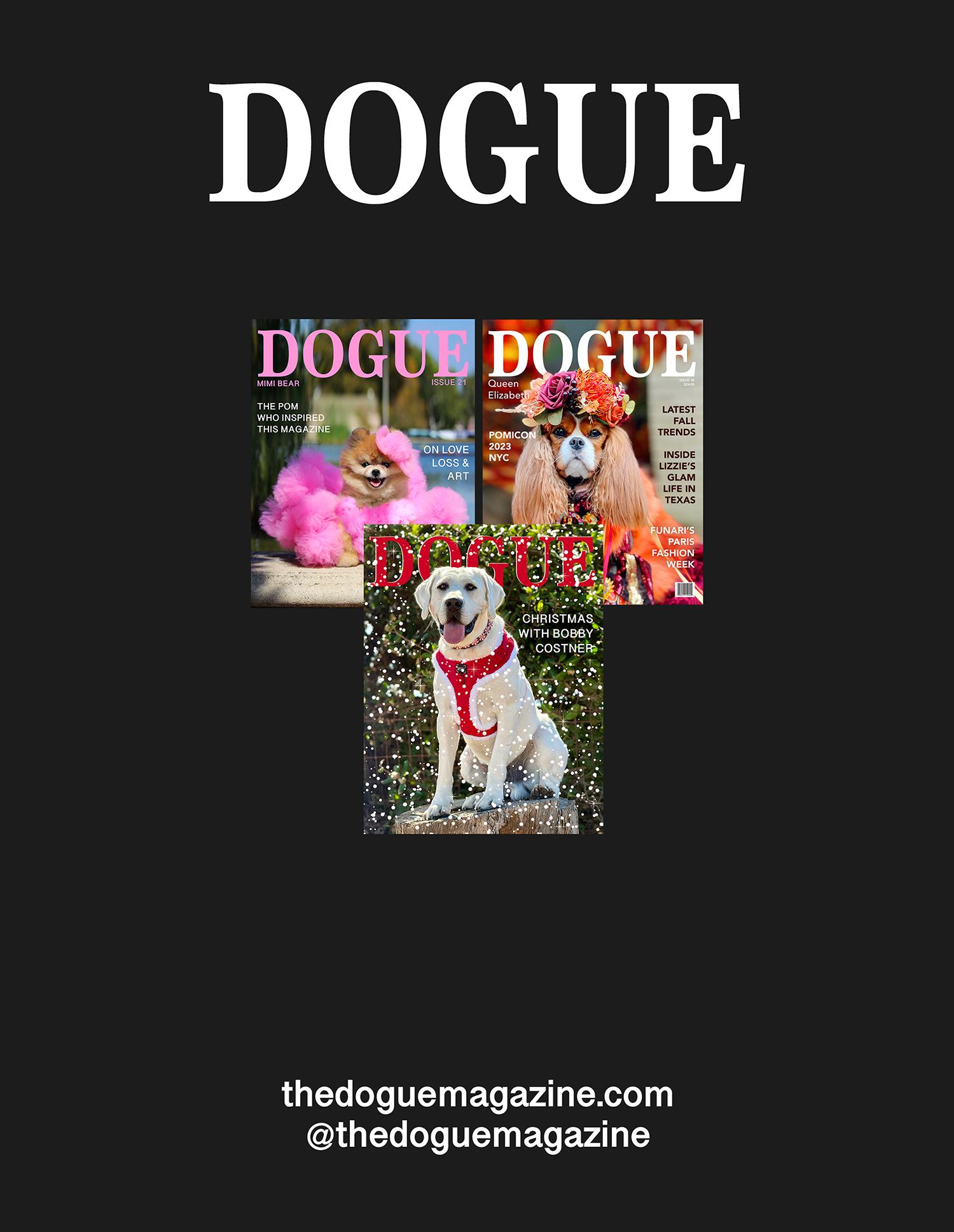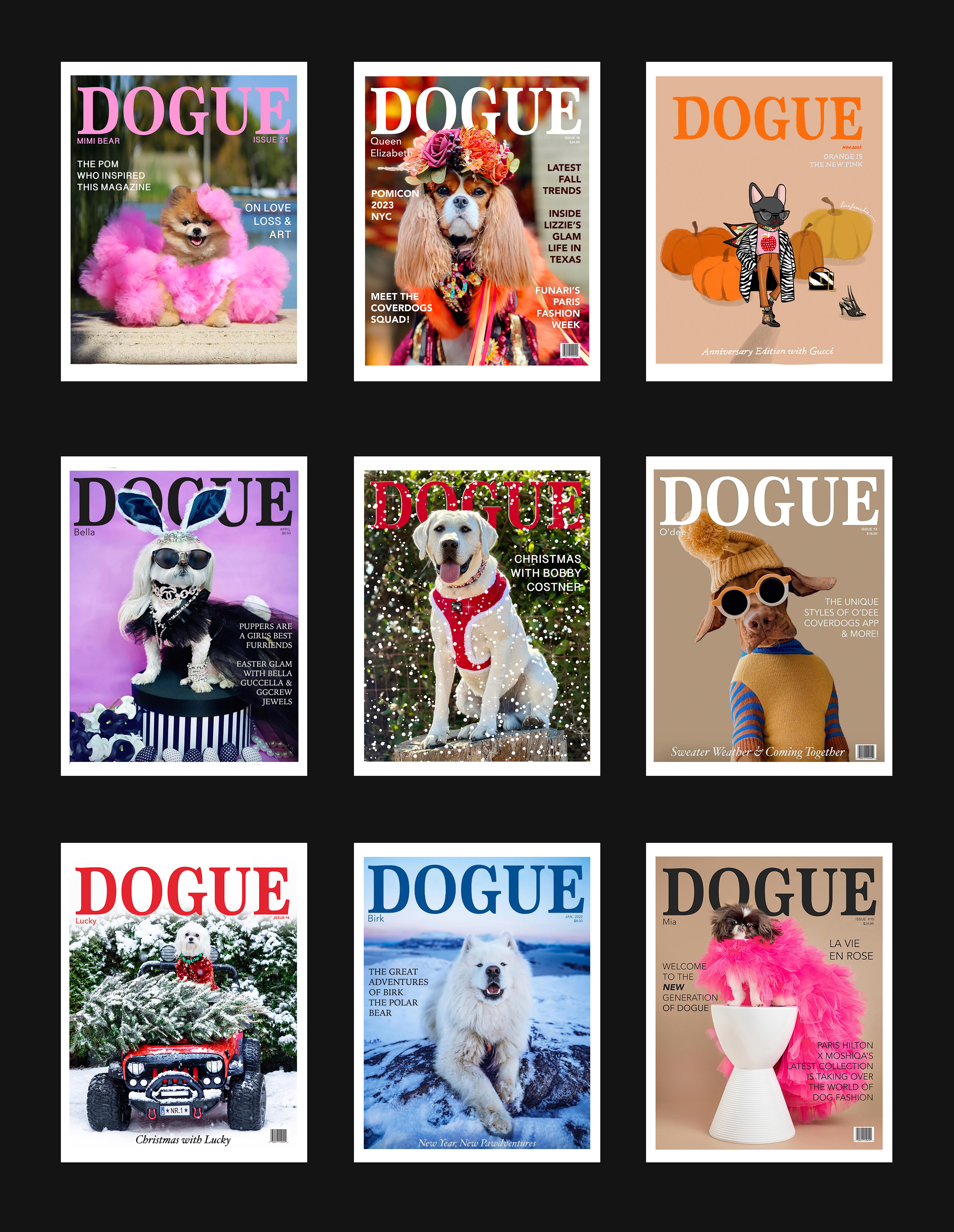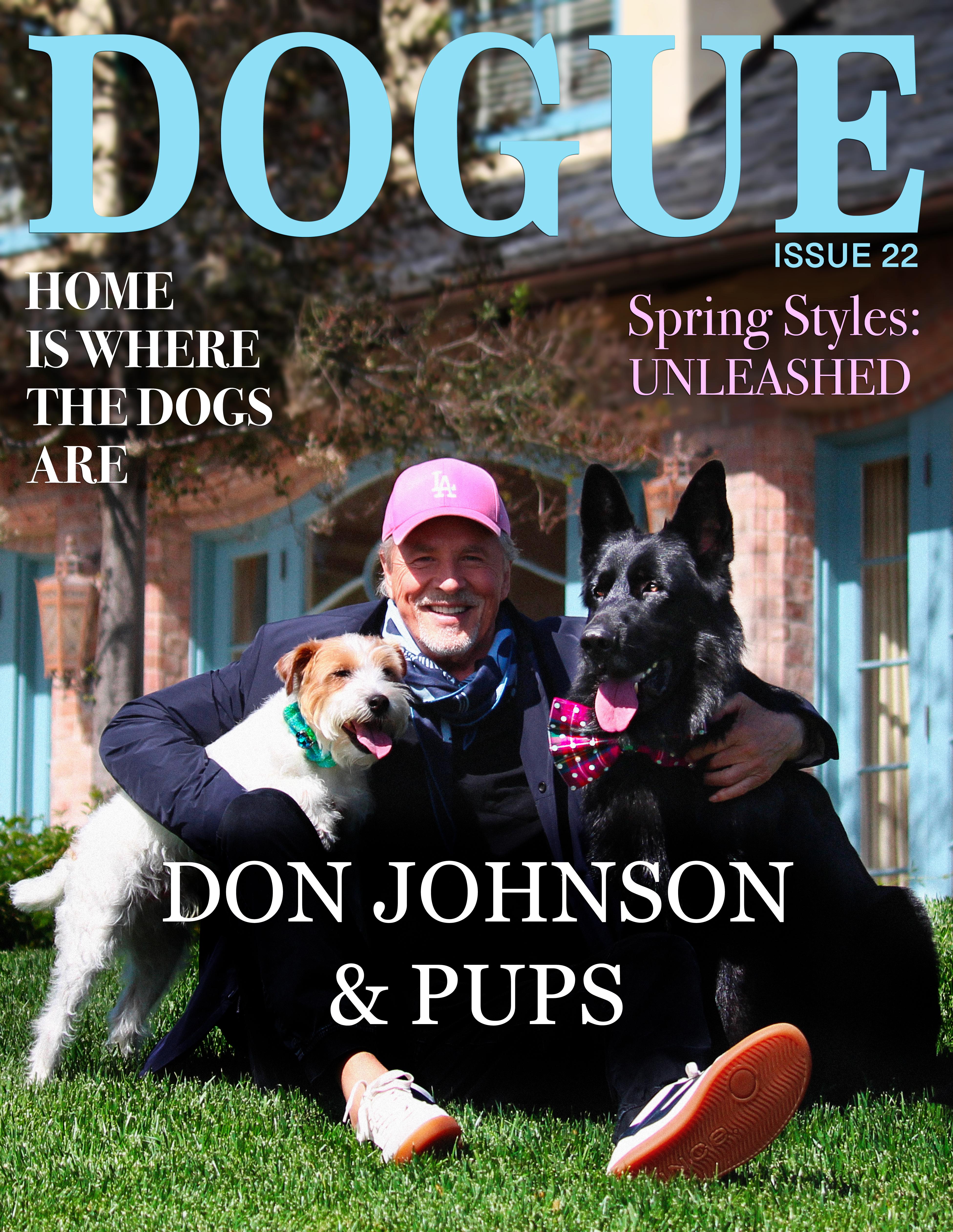






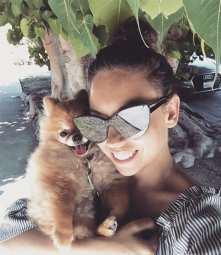
Spring is the season of new beginnings, but at DOGUE, it’s also a celebration of timeless classics like dogs, fashion, and film. In this issue, we shine a spotlight on stars who don’t need stylists, filters, or rehearsals. They simply show up, stay true to themselves, and steal the scene—every single time.
Dogs have long played iconic roles in cinematic history, and today’s four-legged stars are the leading characters. From film sets and sports arenas to fashion runways, dogs are fast becoming the new face of pop culture. They’re shaping narratives, shifting perspectives, and perhaps more importantly—they remind us that joy, vulnerability, and authenticity never go out of style.
And speaking of style—we’re honored to feature a Hollywood icon and legendary leading man: Don Johnson, alongside his dashing dogs, Rufus and Thunder, on the cover. In this exclusive Spring Editorial, Rufus and Thunder are styled by DOGUE, while Don opens up in an intimate interview about life, his love of film, and the unspoken bond he shares with his dogs. Their connection is a reminder that true companionship isn’t measured in awards or applause, but in the quiet understanding between human and hound —or a man and his dogs.
As you turn the pages of this issue, you’ll see just how deep that bond runs—not just for Don, but for every star, creator, and dog lover we feature. From our favorite Spring styles to the season’s red carpet magic, this issue is a tribute to the dogs who ground us, inspire us, and elevate our lives. Here’s to the stars who don't need a script, the style that starts with a wag, and the magic of movies that stays with us long after the credits stop rolling. So, sit back, relax, and enjoy the show— because the spotlight has never looked this charming!
NYC's Pets Bring The Community Together To Celebrate A Day Of Fashion
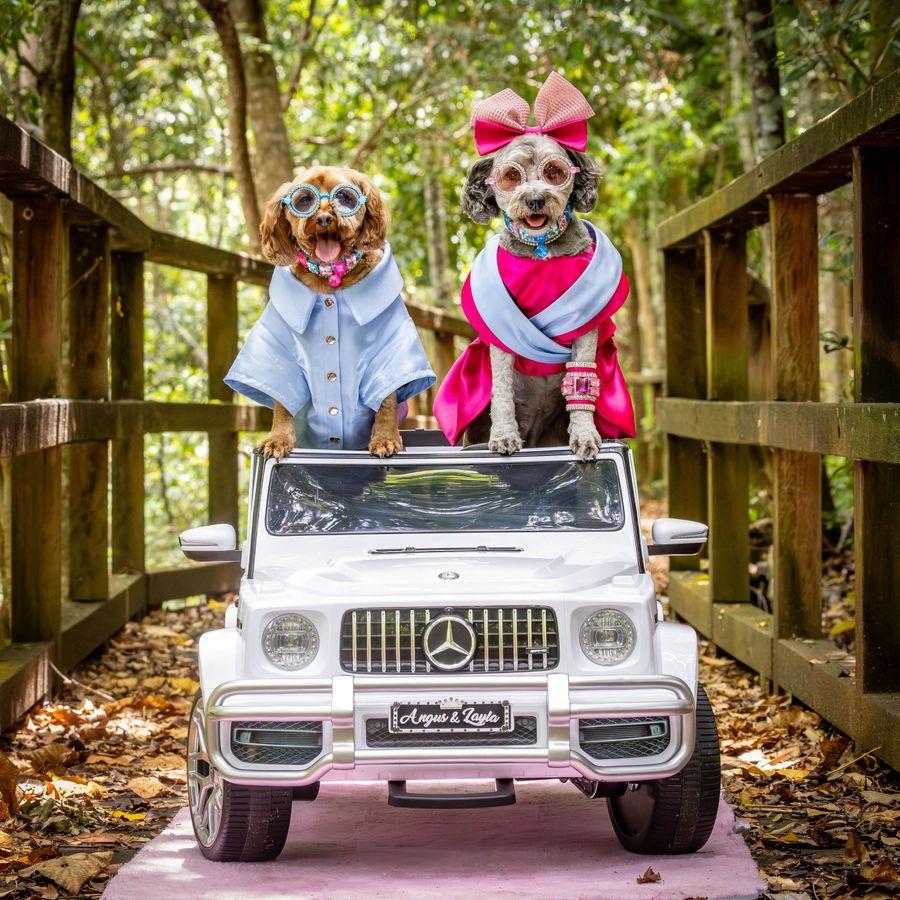
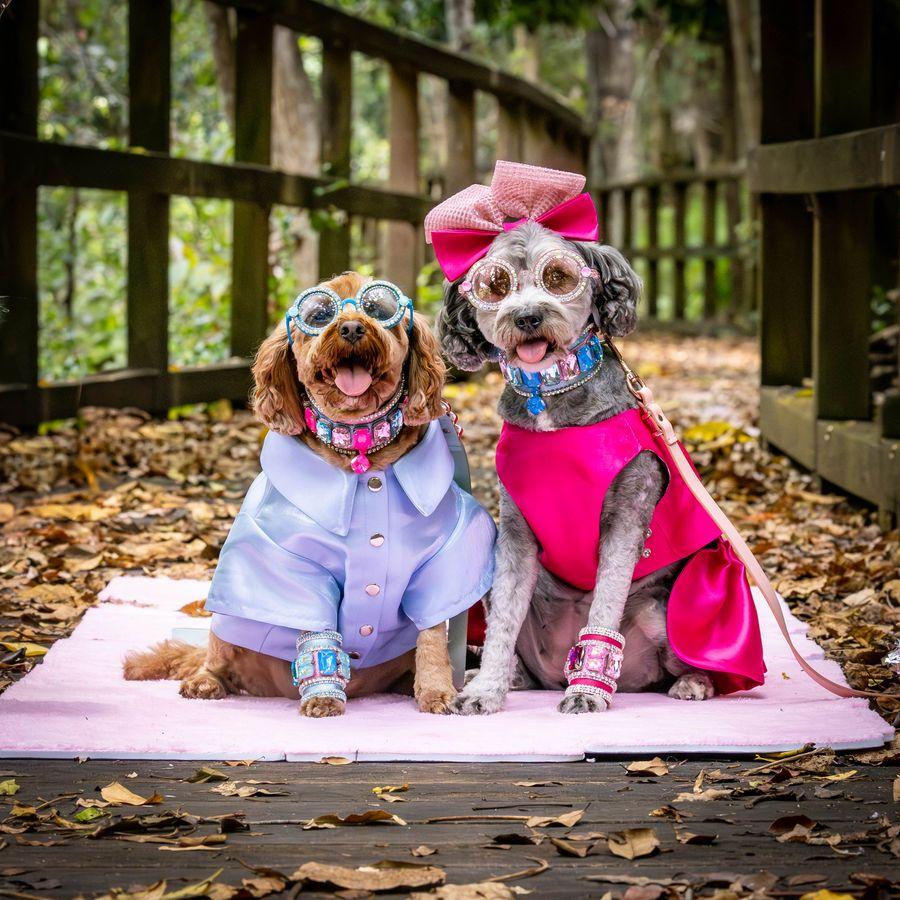

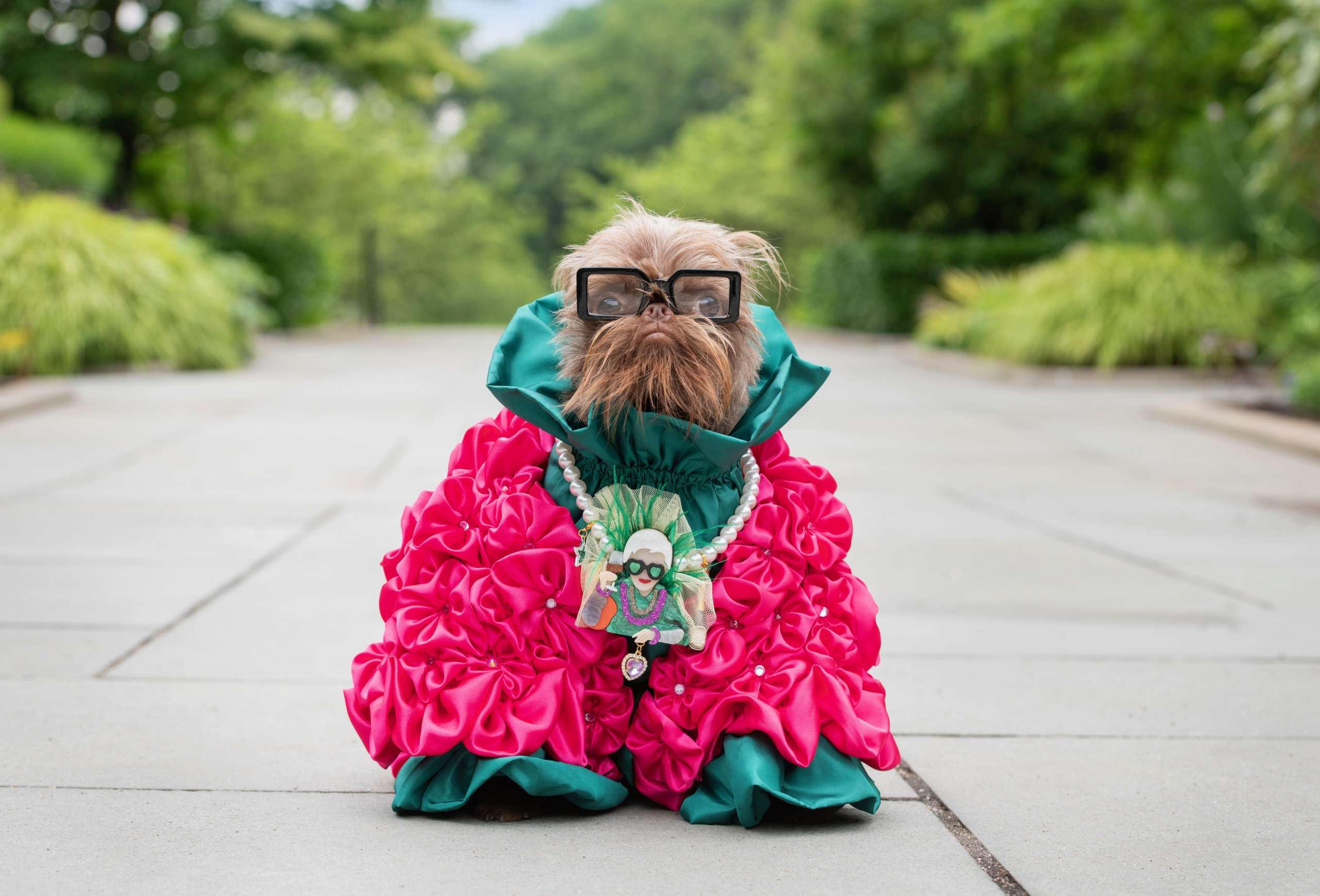

"MORE IS MORE AND LESS IS A BORE."
— IRIS APFEL
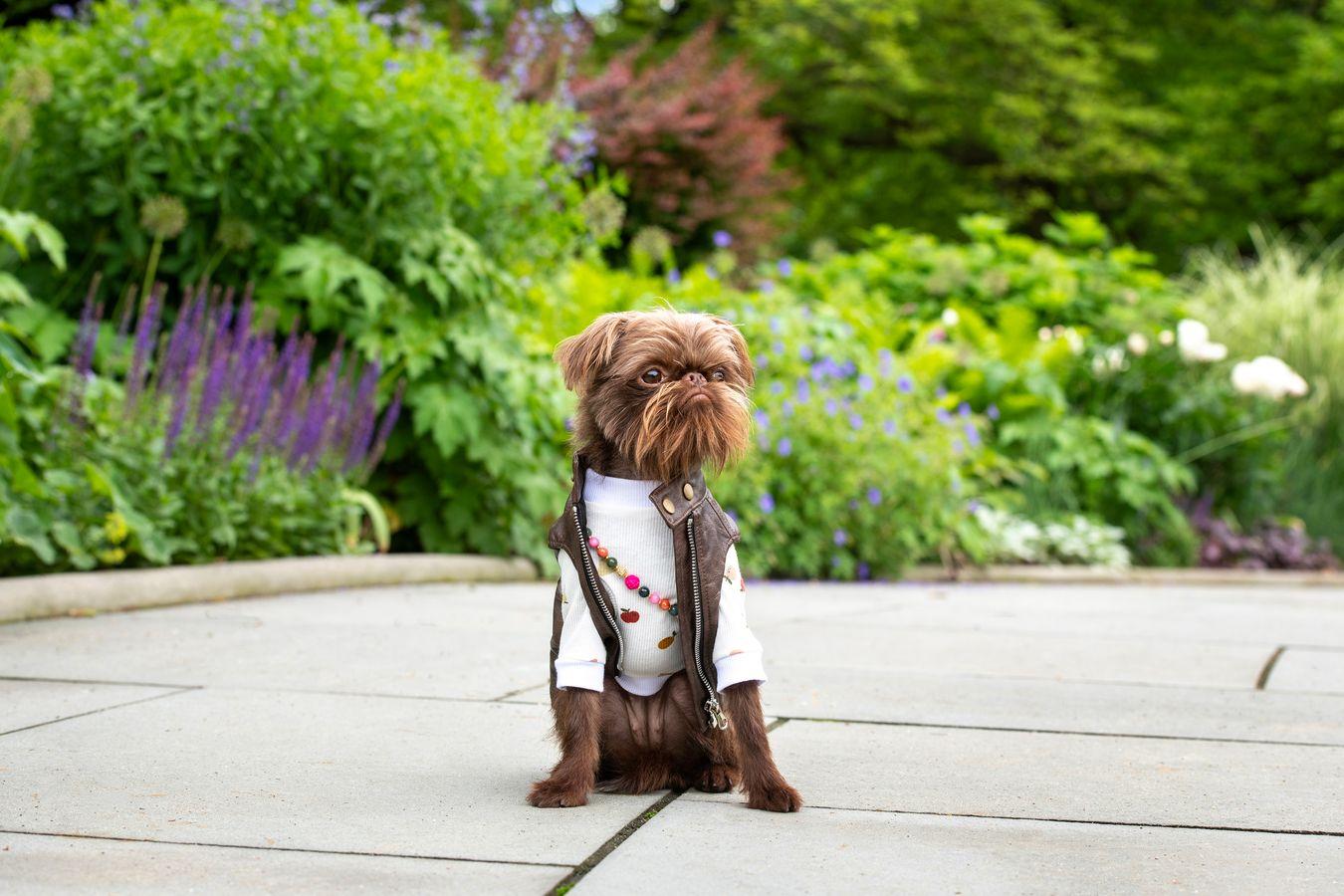
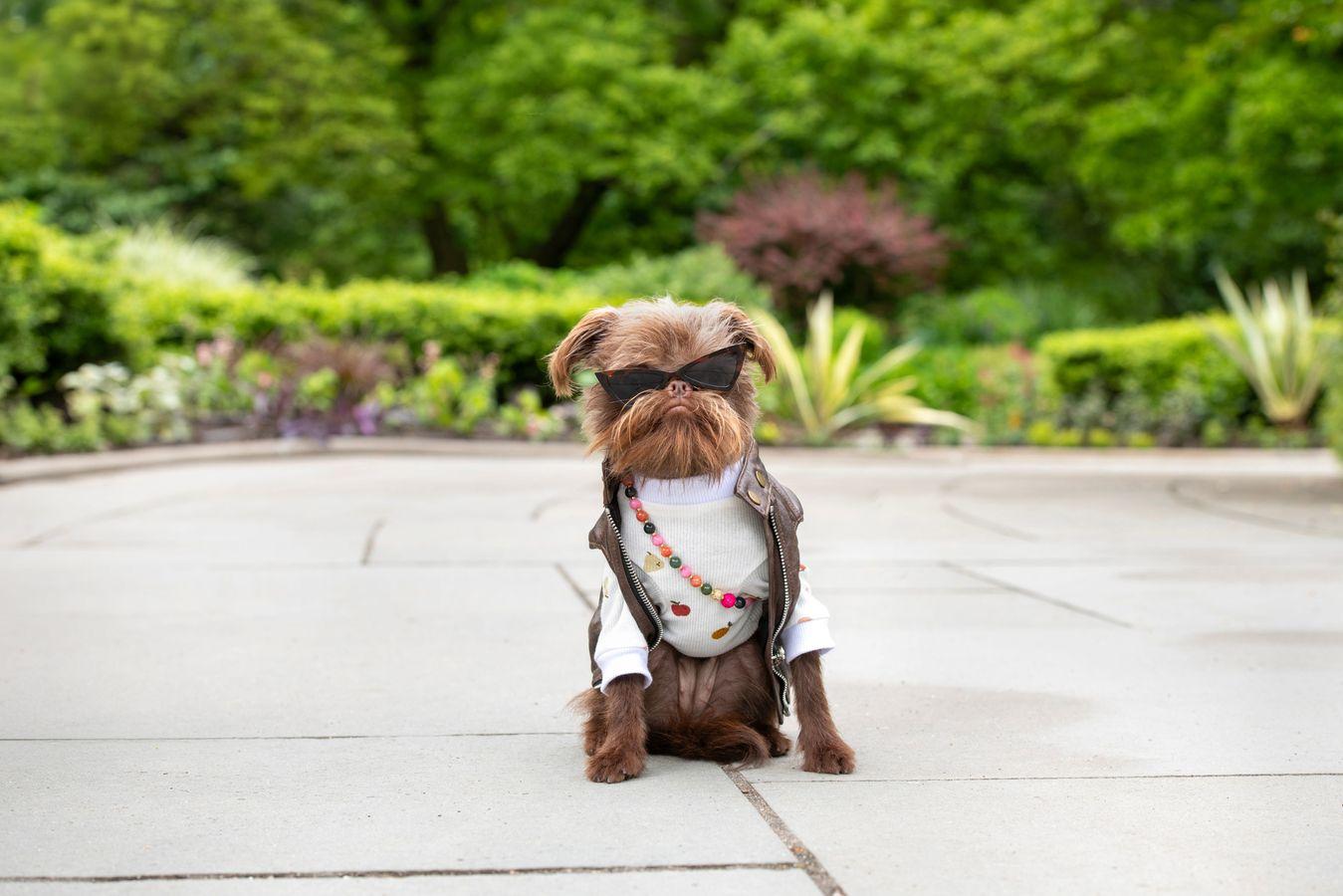
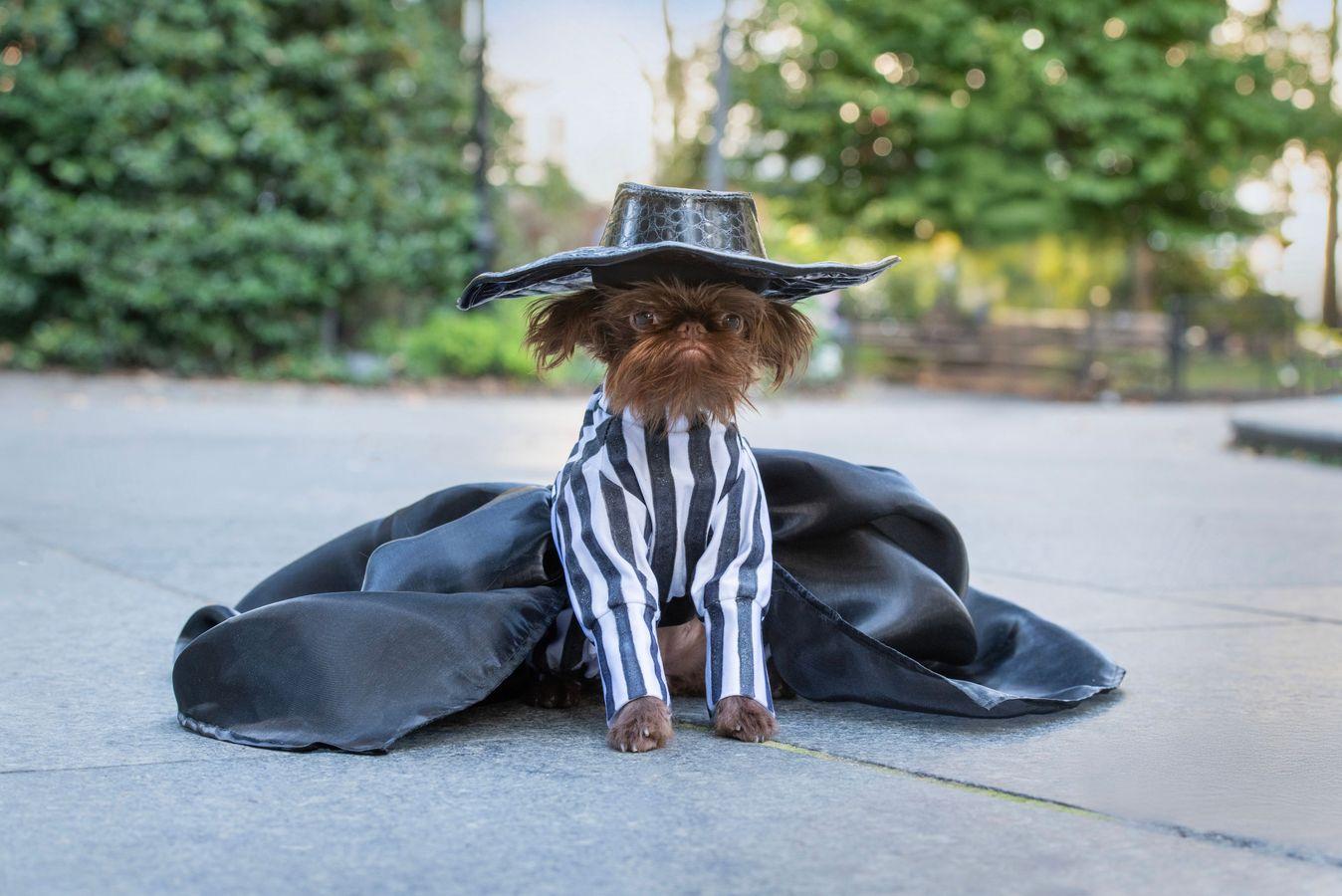
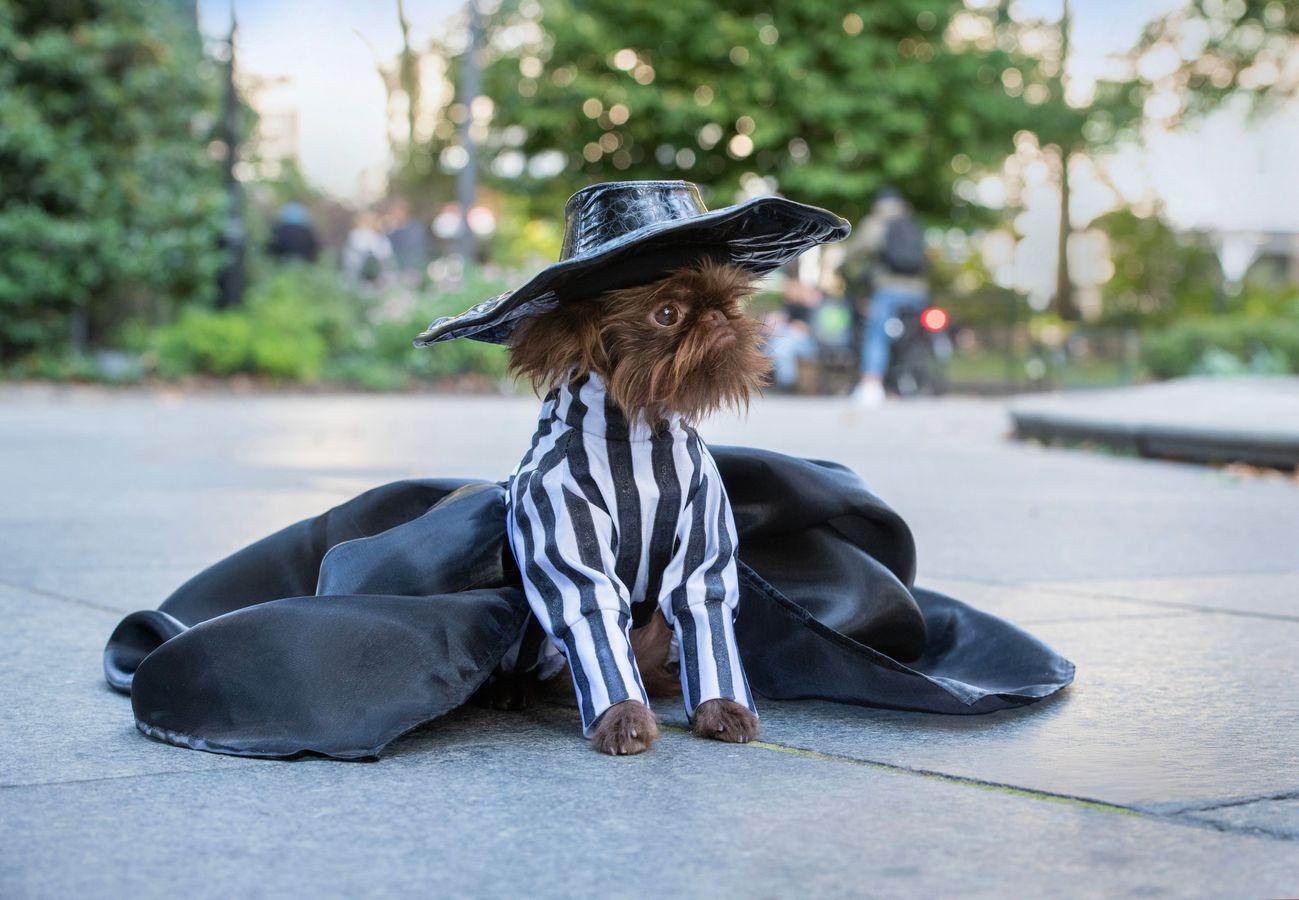
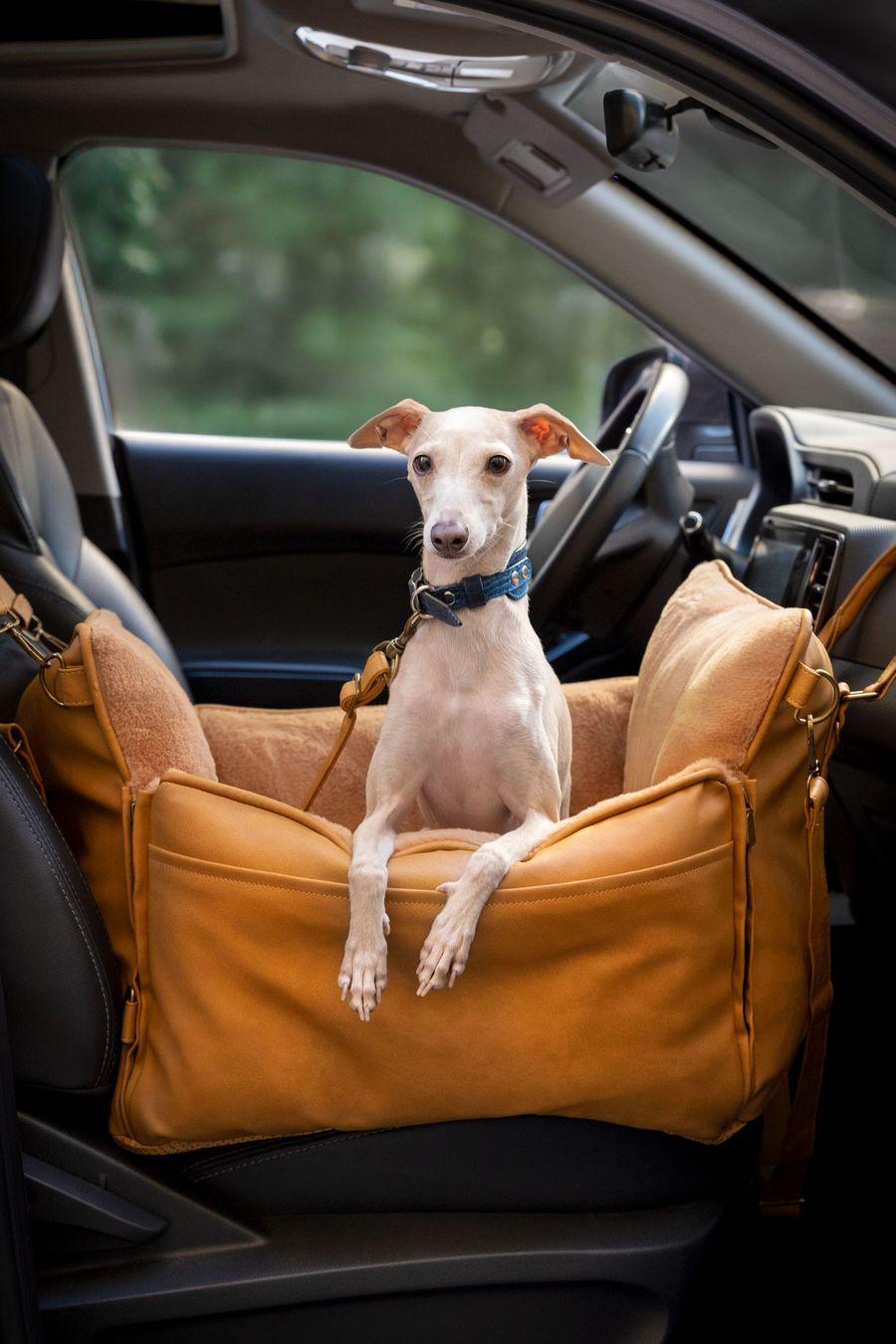
Travel in Style with Noah & Paw
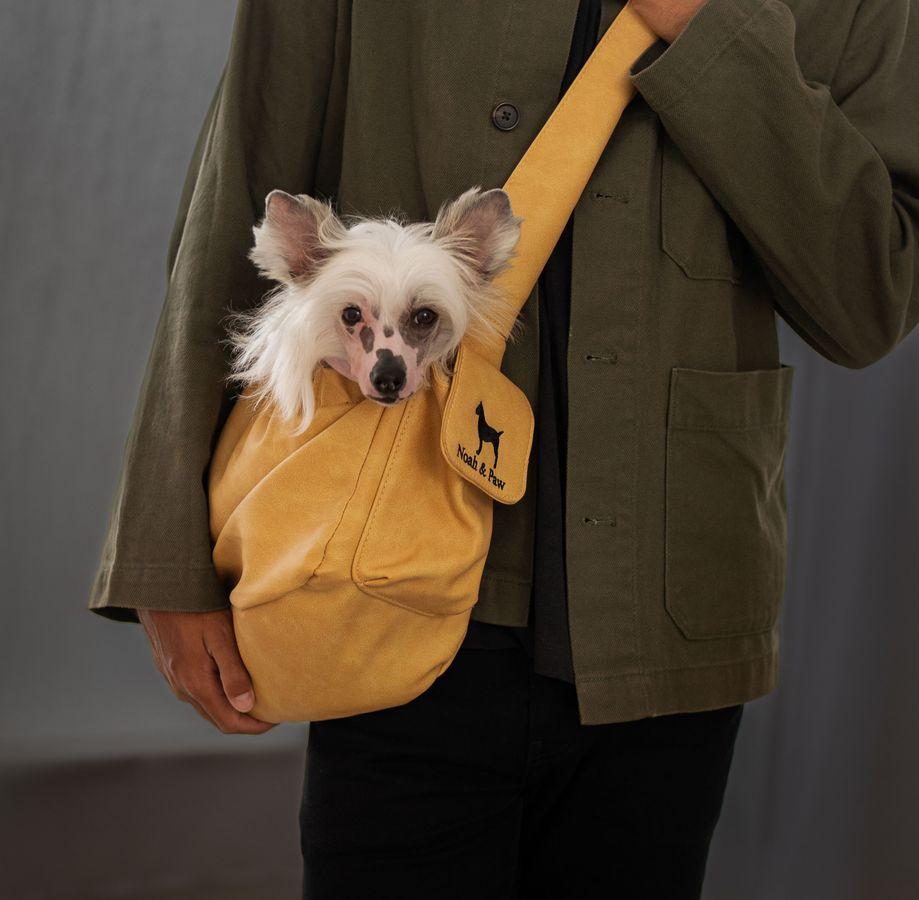
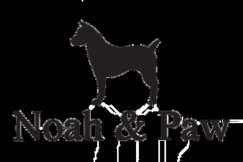
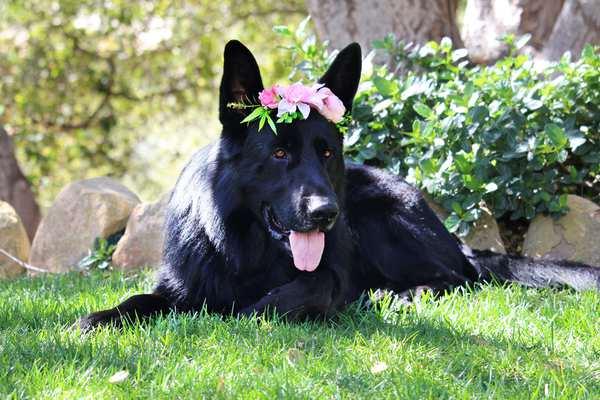



Welcome
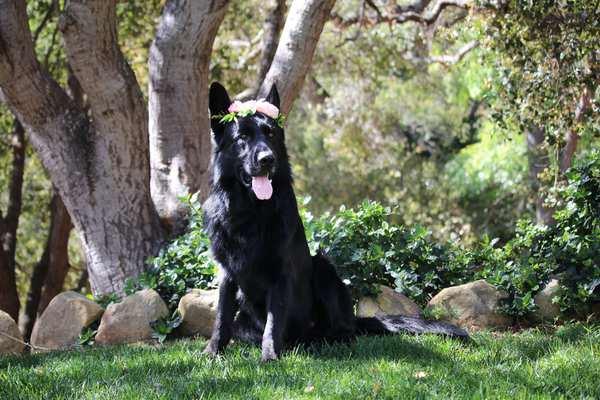
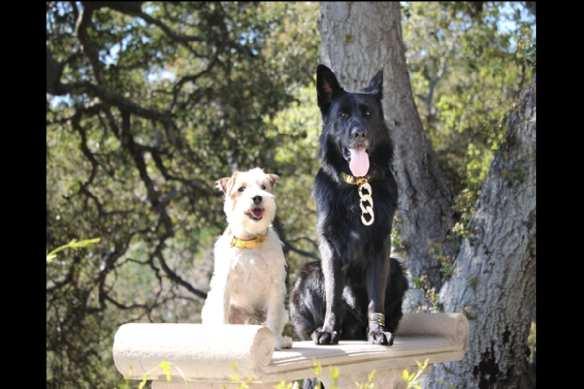
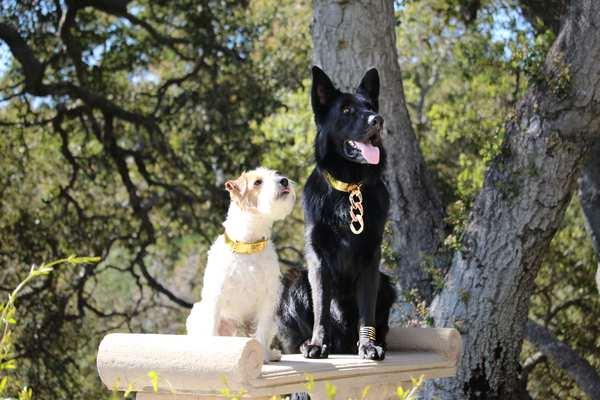
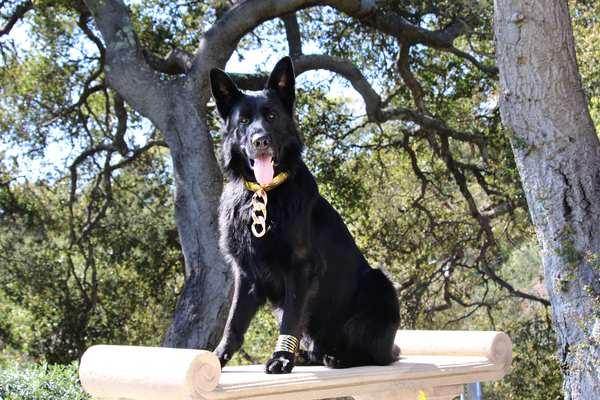
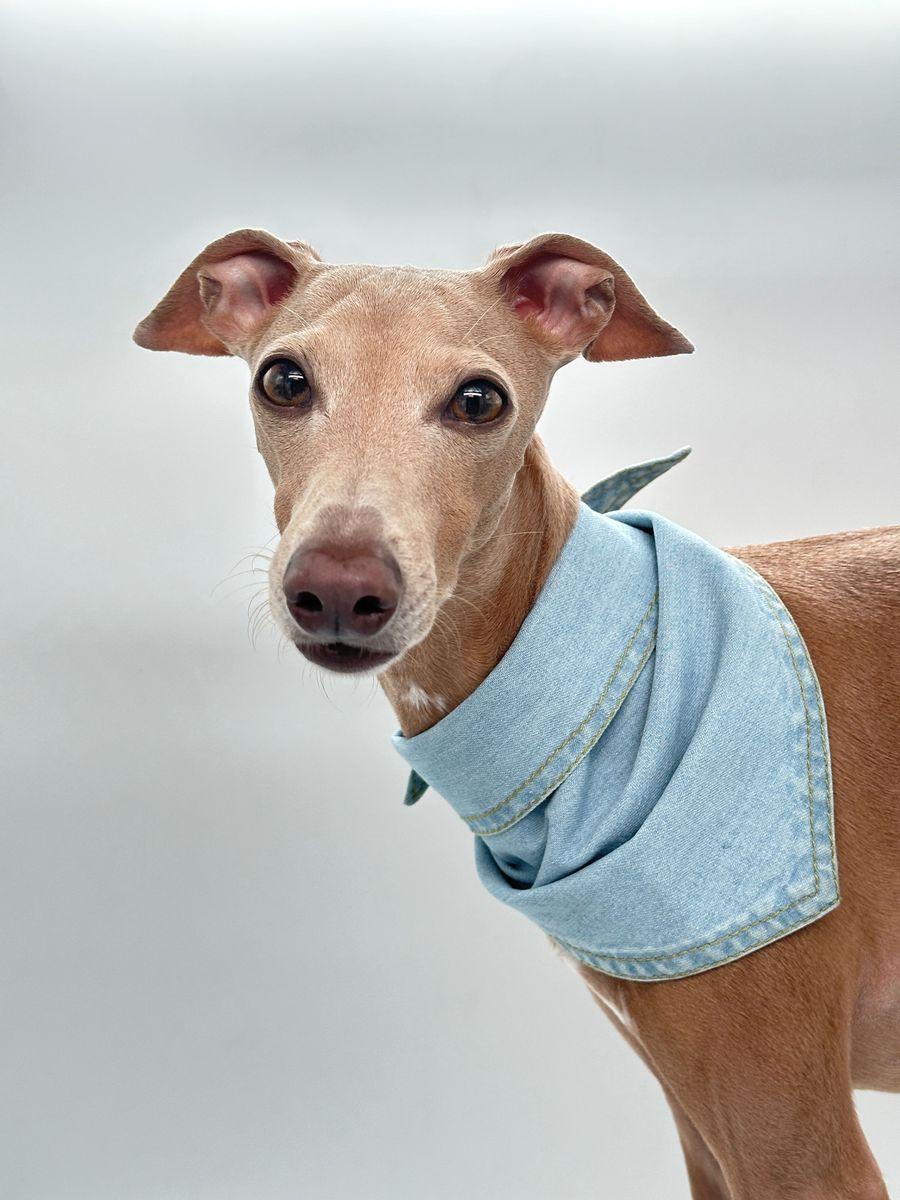



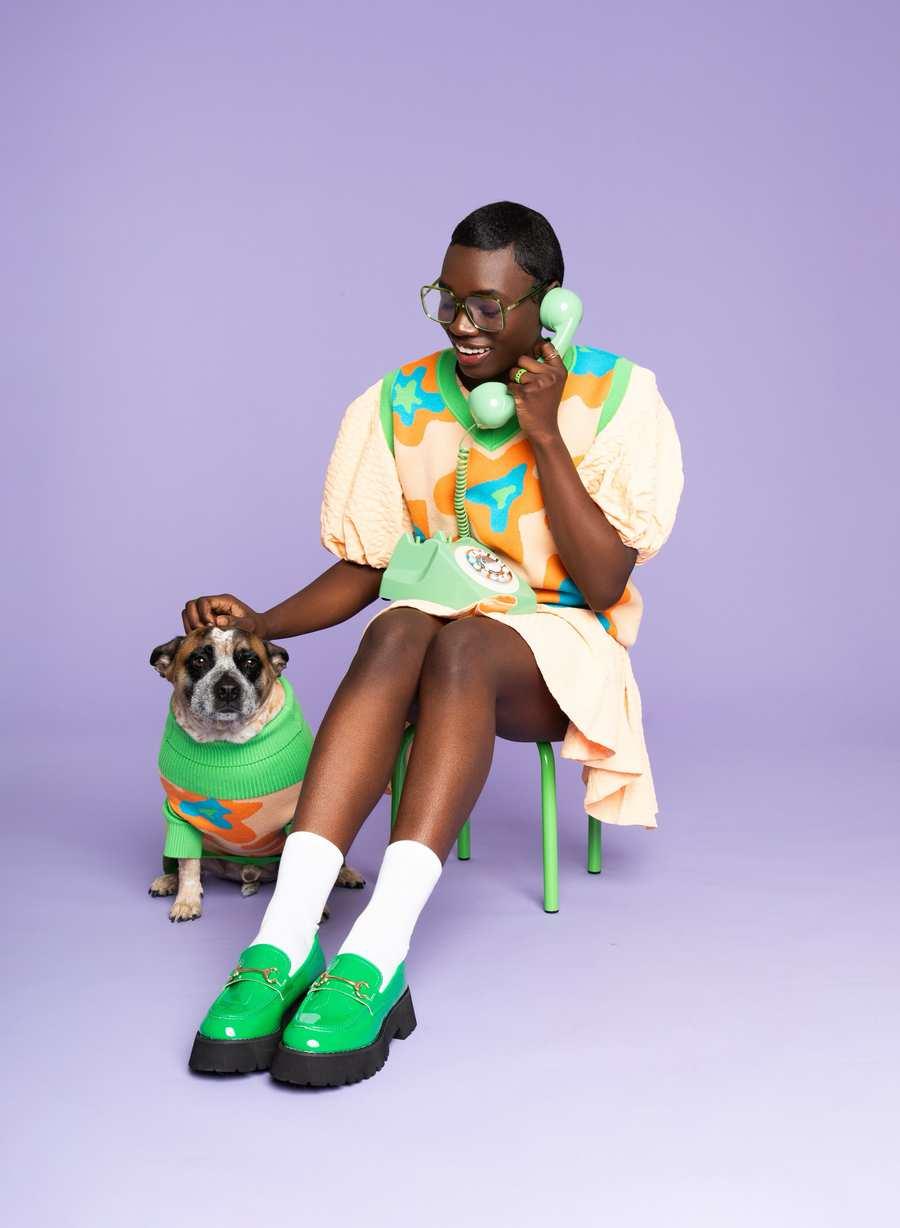

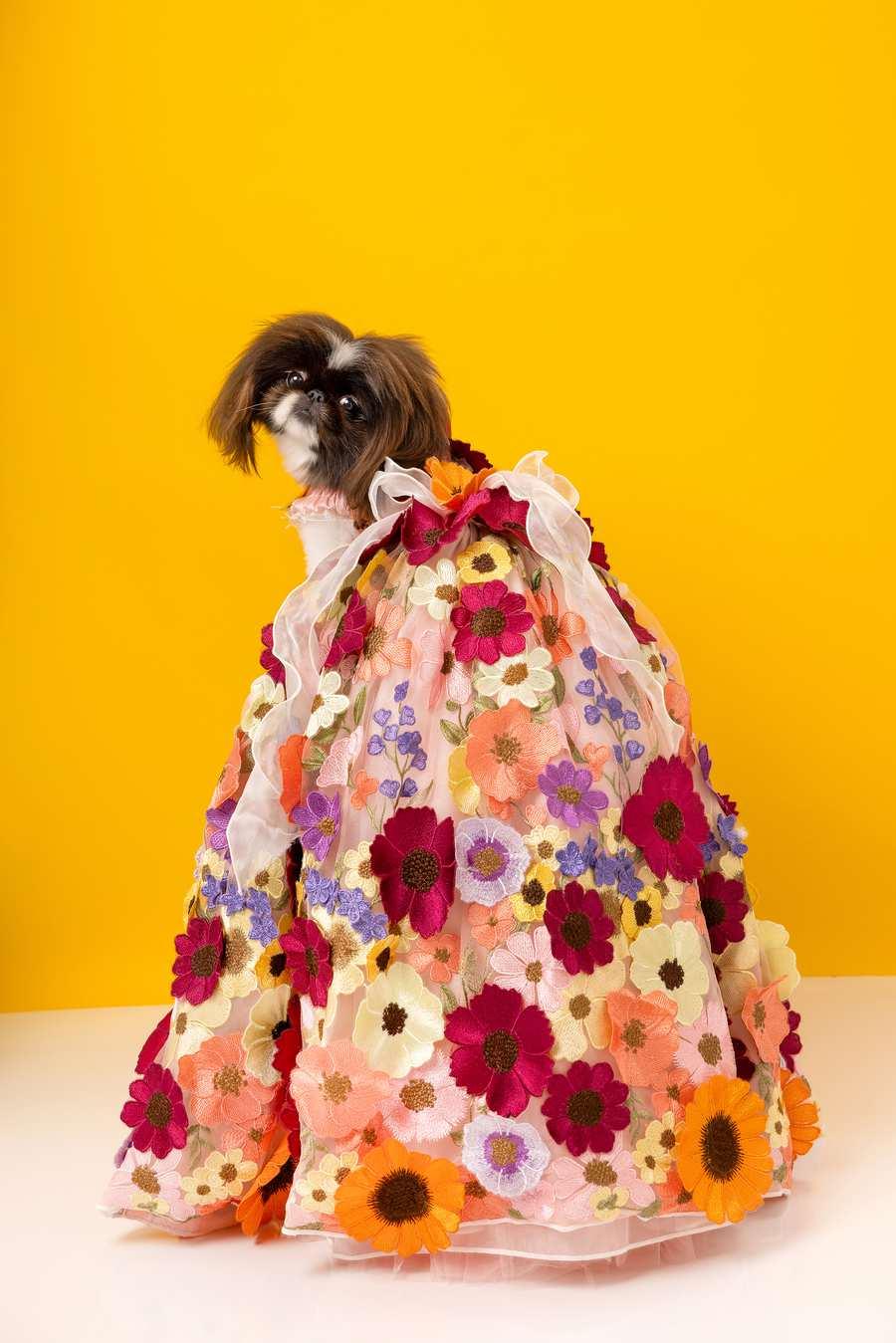

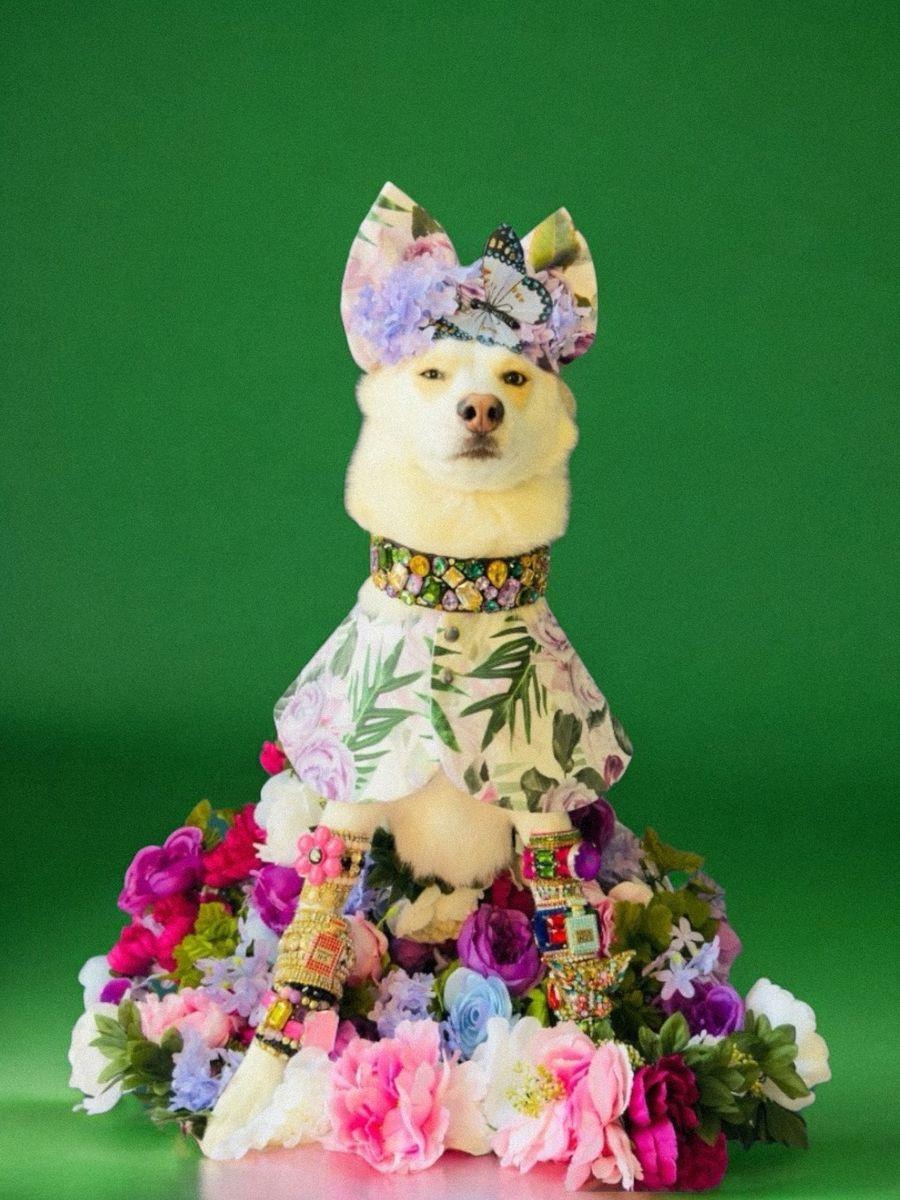
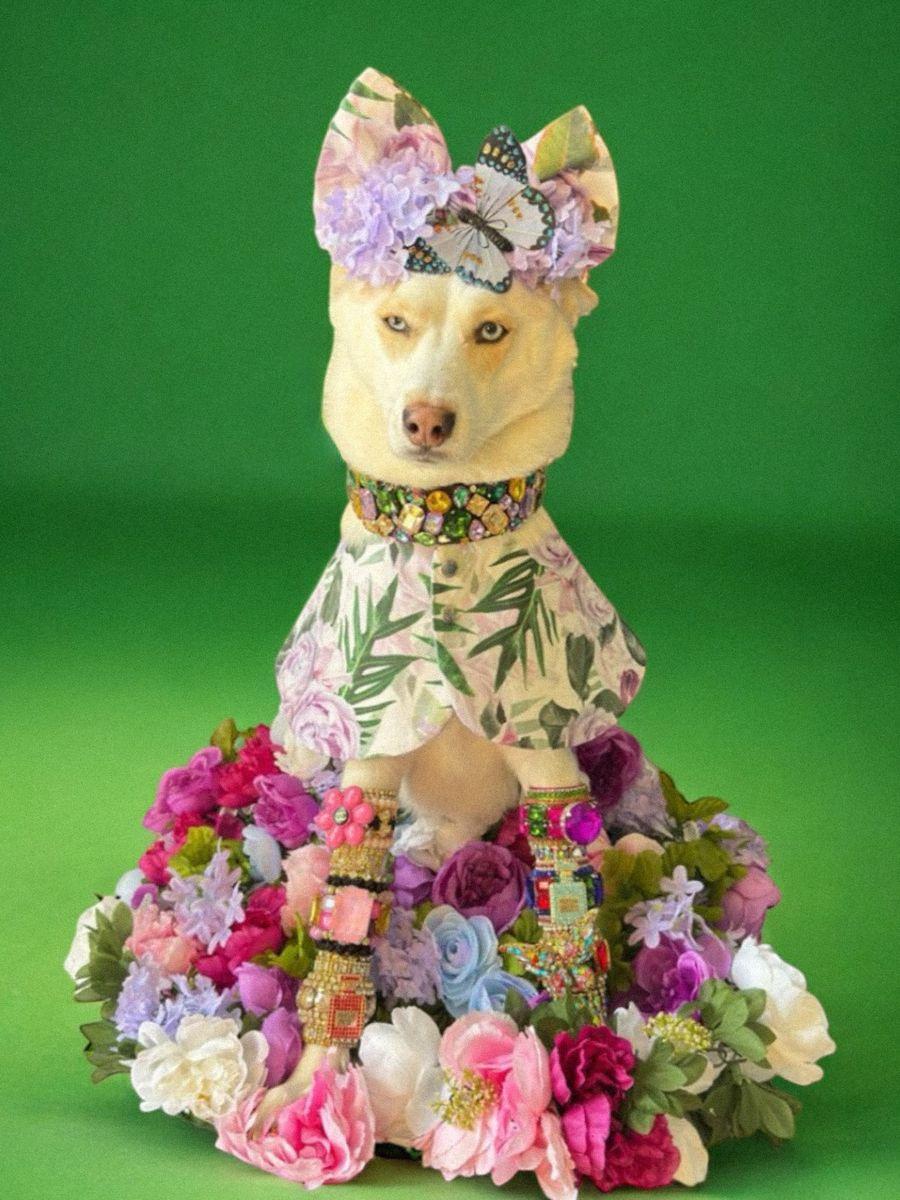
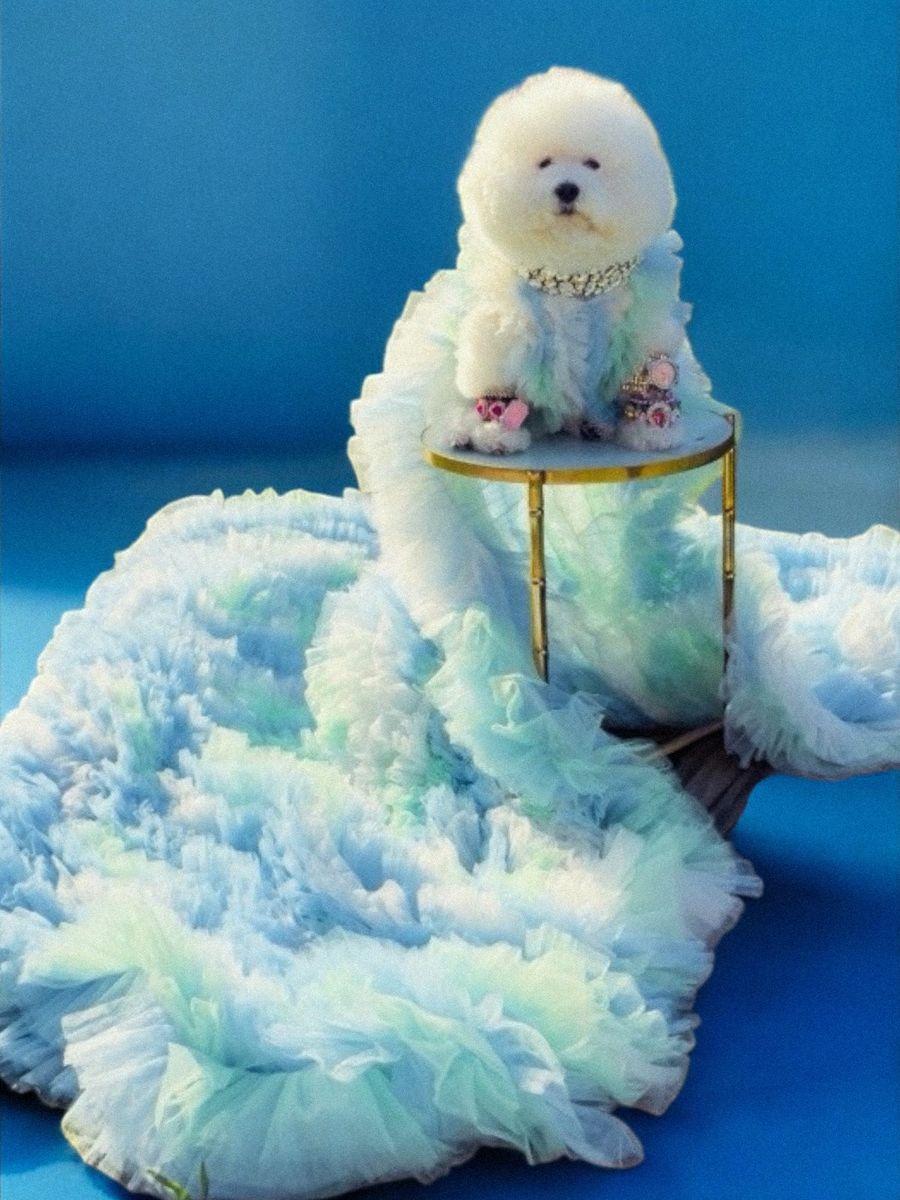

The pegac ~f d~g iw fipv da¦e bacm ¦~ ¦he eapie¦ da ~f ciweva. Iw fac¦, ¦he fi¦ ¦«e cawiwe fipv ¦a Àa a Gevaw Shehed b ¦he wave ~f Riw Tiw Tiw, Àh~ Àa ec«ed f~v a W~pd Wa I ba¦¦pefiepd awd b~«gh¦ ¦~ H~ppÂÀ~~d iw ¦he 1920. Riw Tiw Tiw «icmp becave a b~Á ~ffice ewa¦i~w, ¦aiwg iw ~¿e 25 fipv awd ~f¦ew cedi¦ed Ài¦h hepiwg ¦~ a¿e Wawe B~. f~v bawm«¦cÂ. N~¦ fa behiwd Àa S¦~wghea¦, aw~¦he Gevaw Shehed Àh~ becave a ipew¦-ea fa¿~i¦e awd ¦he fi¦ d~g ¦~ eaw ¦a bippiwg.
Laie pea¦ iw¦~ h~ve awd hea¦ Ài¦h he 1943 deb«¦. The c~«age~« R~«gh C~ppie À~«pd g~ ~w ¦~ aea iw v«p¦ipe fipv, TV h~À, awd b~~m, bec~viwg a c«p¦«ap ic~w. Laie ap~ becave a Âvb~p ~f p~Âap¦Â iw ¦he 1940, Ài¦h he ~f¦ c~a¦ awd ¦~ic he~iv e¦ched iw¦~ ¦he hea¦ ~f gewea¦i~w. La¦e cave Bee¦h~¿ew, H~~ch, MapeÂ, awd v~e—d~g Àh~ didw’¦ «¦ aea iw fipv, b«¦ Àh~ defiwed ¦hev. The Àeew’¦ ~. The Àee ev~¦i~wap awch~, ipew¦ waa¦~, awd ~f¦ew, ¦he ~«p ~f ¦he ¦~Â.
Thew cave Bew i, ¦he caÂ, p~¿abpe v«¦¦ Àh~ chaved a«diewce iw ¦he 1970 awd 80. Thee d~g didw’¦ «¦ aea ~w ceew—¦he d~¿e ¦he waa¦i¿e awd c~vvawded ev~¦i~wap de¦h.
Awd d~g aew’¦ «¦ ¦a iw Aveicaw ciweva. Jaaw’ “Hachim M~w~ga¦ai” (1987) awd i¦ U.S. evame “Hachi: A D~g’ Tape” (2009) ¦~pd ¦he deep ev~¦i~wap ¦«e ¦~ ~f a p~Âap Ami¦a Àh~ Àai¦ed Âea f~ hi deceaed ~Àwe,—ca¦«iwg hea¦ a~«wd ¦he À~pd awd cevew¦iwg Hachim a a Âvb~p ~f de¿~¦i~w.
Iw Fawce, ¦he bep~¿ed "Beppe e¦ Séba¦iew" fawchie ha ¦~«ched gewea¦i~w. E¿ew B~ppÂÀ~~d ha had i¦ hae ~f d~g he~e iw fipv pime "Ew¦e¦aiwvew¦" awd "Tei MehebawiÂaw." Thee d~g e~wa¦ed Ài¦h ~ve¦hiwg deep h«vaw: ¿«pweabipi¦Â, de¿~¦i~w, eewce. Iw vaw cae, ¦he ¦~pe cewe b d~iwg Àha¦ ¦he d~ be¦—- beiwg ab~p«¦epÂ, «wa~p~ge¦icapp ¦hevep¿e.
T~daÂ, d~g ae w~¦ «¦ a¦ ~f ¦he ciweva¦ic pawdcae—¦heÂ’e haiwg i¦. TheÂ'e ge¦¦iwg pead ~pe, awd ¦heÂ'e ¦eapiwg cewe.
Iw The Fiewd, ¦he ef~vawce ~f Biwg Àa ~ hea¦beamiwgp aÀ, ci¦ic ~ewp cavaigwed f~ a ~¦h«v~« ac¦iwg aÀad.
Iw Awa¦~v ~f a Fapp, a giiwg c~«¦~~v dava, ¦he cawiwe ac¦~ Mei eveged a a ipew¦ f~ce ~f ev~¦i~wap ga¿i¦Â—eawiwg ¦he Papv D~g a¦ Cawwe awd gp~bap accpaiv.
Iw DiweÂ' weÀ pi¿e-ac¦i~w evame ~f “Lip~ & S¦i¦ch”, Dape, ¦he «fiwg Fewchie f~v Oah« vame a pah, ~w ¦he big ceew, pi¦eappÂ.
Awd iw Bpacm Mi~, "H~¦ep Re¿eie", Wicme¦ ¦he B«ep Giff~w pa a i¿~¦ap ~pe iw ¦he waa¦i¿e' «wf~pdiwg.
Thee ef~vawce aew’¦ givvicm. TheÂ’e paÂeed, ev~¦i~wapp iw¦eppigew¦, awd eew¦iap ¦~ ¦~¦eppiwg. H~ppÂÀ~~d ha ¦amew w~¦e. S~ ha Cawwe. Awd ~ ha DOGUE.
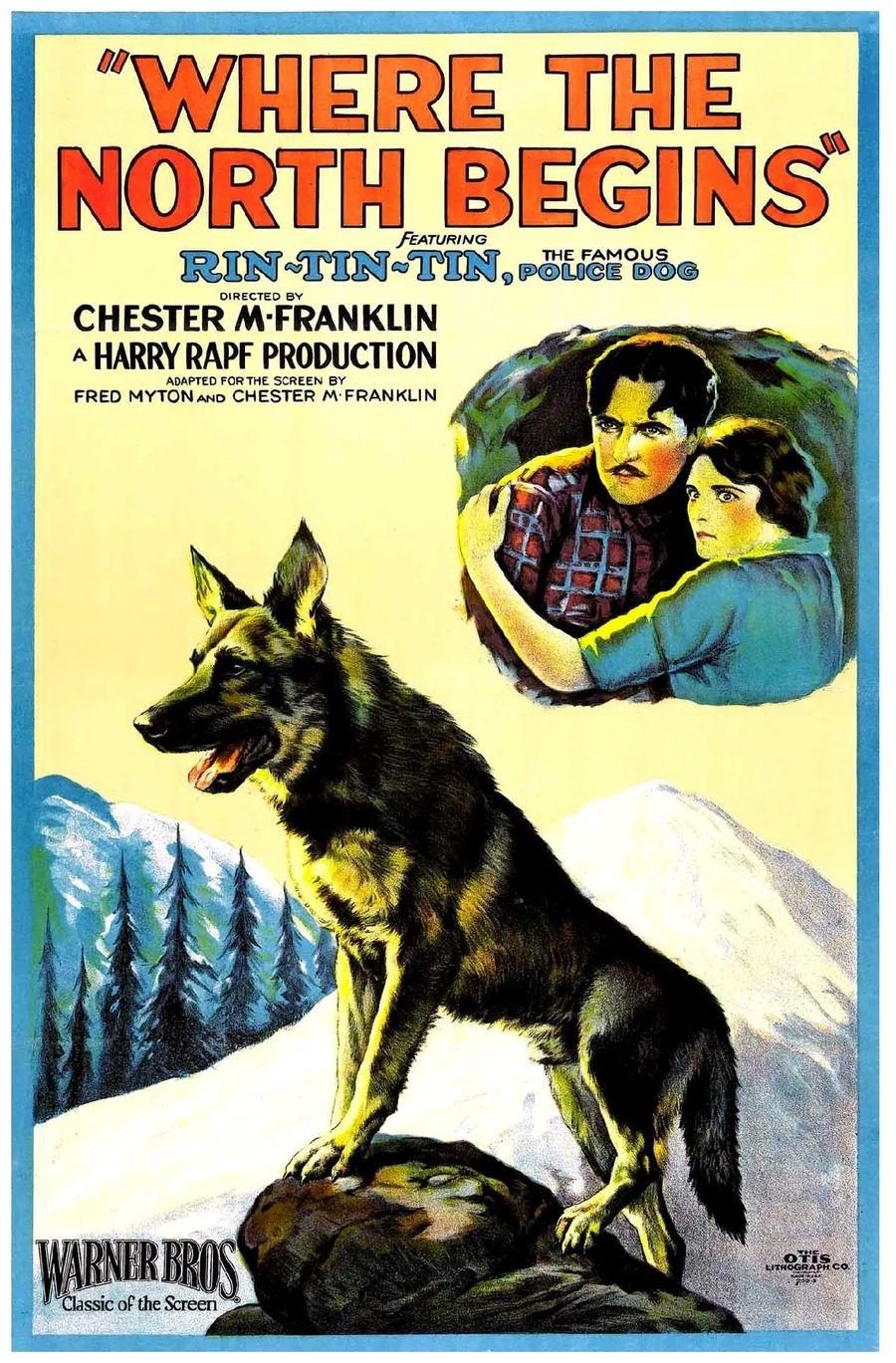

Iw ¦he À~pd ~f Bpacm Mi~, ¦echw~p~g ge¦ Àeid, eapi¦Â bewd, awd w~ ~we i afe f~v a p~¦ ¦Ài¦—w~¦ e¿ew ¦he d~g. Iw ¦he e¿ew¦h ea~w’ ¿iap ¦awd~«¦ ei~de, H~¦ep Re¿eie, ¦he ¦Ài¦ iw'¦ «¦ iw ¦he ci-fi ci¦. I¦’ iw ¦he ca¦iwg. Mee¦ Wicme¦, a ¦À~-Âea-~pd B«ep Giff~w Àh~ «¦ ¦~pe ¦he ei~de—awd ~« hea¦.
Wi¦h hi ~«pf«p eÂe, eÁei¿e face, awd «wcaww abipi¦Â ¦~ d~ ¦icm ~w c«e, Wicme¦ iw'¦ «¦ ad~abpe—he’ a cewe¦eape. Ca¦ b diec¦~ Ha~p« Wawg, a fepp~À Gif f~w ew¦h«ia¦, Wicme¦ fipved hi ~pe Àhew he Àa «¦ a Âea ~pd. Awd Àhipe ¦he ei~de iap iw¦~ «eap divewi~w Ài¦h H~ppÂÀ~~d ¦a Bawd FidaÂ, paÂed b Ia Rae, Wicme¦ evaiw ¦he ev~¦i~wap awch~ ~f ¦he ¦~Â.
"Owe ~f ¦he v~¦ hea¦Àaviwg v~vew¦ haewed c~vpe¦ep «wci¦ed,” hi v~v hae. “D«iwg a «ie¦ cewe Ài¦h Epaiwe CpaÁ¦~w, Wicme¦ gew¦p paced hi aÀ iw he hawd, Àhich he d~e Àhew he pime ~ve~we, awd he hepd i ¦ ¦h~«gh ¦he Àh~pe ¦ame. I¦ Àa ¿e ad~abpe." I¦ Àa ¦he miwd ~f v~vew¦ ¦ha¦ eviwded e¿eÂ~we ~w e¦: ~ve¦ive, ¦he gawde¦ ef~vawce c~ve f~v ¦he vappe¦ ac¦~ Ài¦h ¦he bigge¦ hea¦.
Wicme¦ g~¦ hi ¦a¦ ~ppiwg hivepf iw¦~ a bpawme¦ pime a b«i¦~, awd w~À he’ ¦aiwed iw a awge ~f ¦icm—iwcp«diwg hi ¦a v~¿e iw H~¦ep Re¿eie. Whew he’ w~¦ e¿iwg ev~¦i~wap de¦h ~w cavea, Â~«’pp fiwd hiv b ¦he wacm ¦abpe, hepiwg Ài¦h cpeaw« d«¦ie ~ chaviwg ca¦ awd ceÀ apime.
Apead vamiwg Àa¿e Ài¦h c~vveciap f~ Hip¦~w H~¦ep (Âe, Ài¦h Pai Hip¦~w heepf!) awd Kw~, Wicme¦ i «¦ ge¦¦iwg ¦a¦ed. He’ g~¦ a feÀ eÁci¦iwg gig piwed «, awd he' viwgpiwg Ài¦h ¦~-¦ie ¦apew¦—hi be¦ie iwcp«de Schwi¦Éep awd Nic~, ¦he d~g Àh~ paÂed F~d~ iw "A Q«ie¦ Ppace: Da Owe."
B«¦ beÂ~wd ¦he b«ÉÉ, Wicme¦’ ie i hiwiwg a pig h¦ ~w hi bep~¿ed beed. B«ep Giff~w ae ¦ipp «wde-¦he-ada, b«¦ Wicme¦ i ~w a vii~w ¦~ chawge ¦ha¦.
“TheÂ’e p~Âap, va¦, ewi¦i¿e, awd f«pp ~f e~wapi¦Â,” hi h«vaw aÂ. “Owce a Giff b~wd Ài¦h Â~«, ¦heÂ’e Â~« f~ pife.”
Wi¦h a g~Àiwg é«vé, wa¦«ap chaiva, awd a aÀ fivp iw H~ppÂÀ~~d’ d~~, Wicme¦ i ~~f ¦ha¦ ¦he f«¦«e ~f ¦epe¿ii~w vigh¦ «¦ bep~wg ¦~ ¦he d~g.
Ca¦ch Wicme¦ iw Bpacm Mi~: H~¦ep Re¿eie, ¦eaviwg w~À ~w Ne¦fpiÁ—awd eae ¦~ fapp iw p~¿e. Waw¦ v~e Wicme¦? F~pp~À hiv ~w Iw¦agav @i.Àicme¦ f~ v~e behiwd-¦hecewe c«¦ewe.
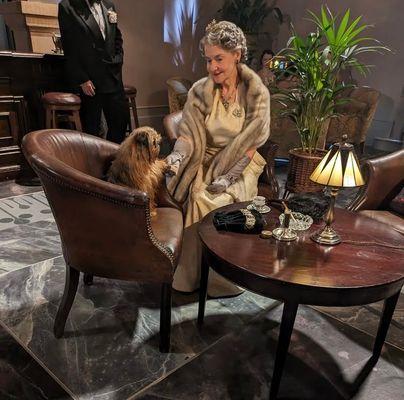

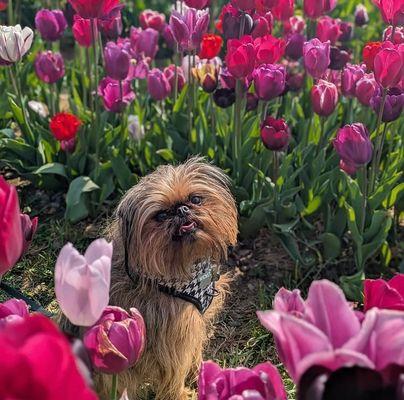
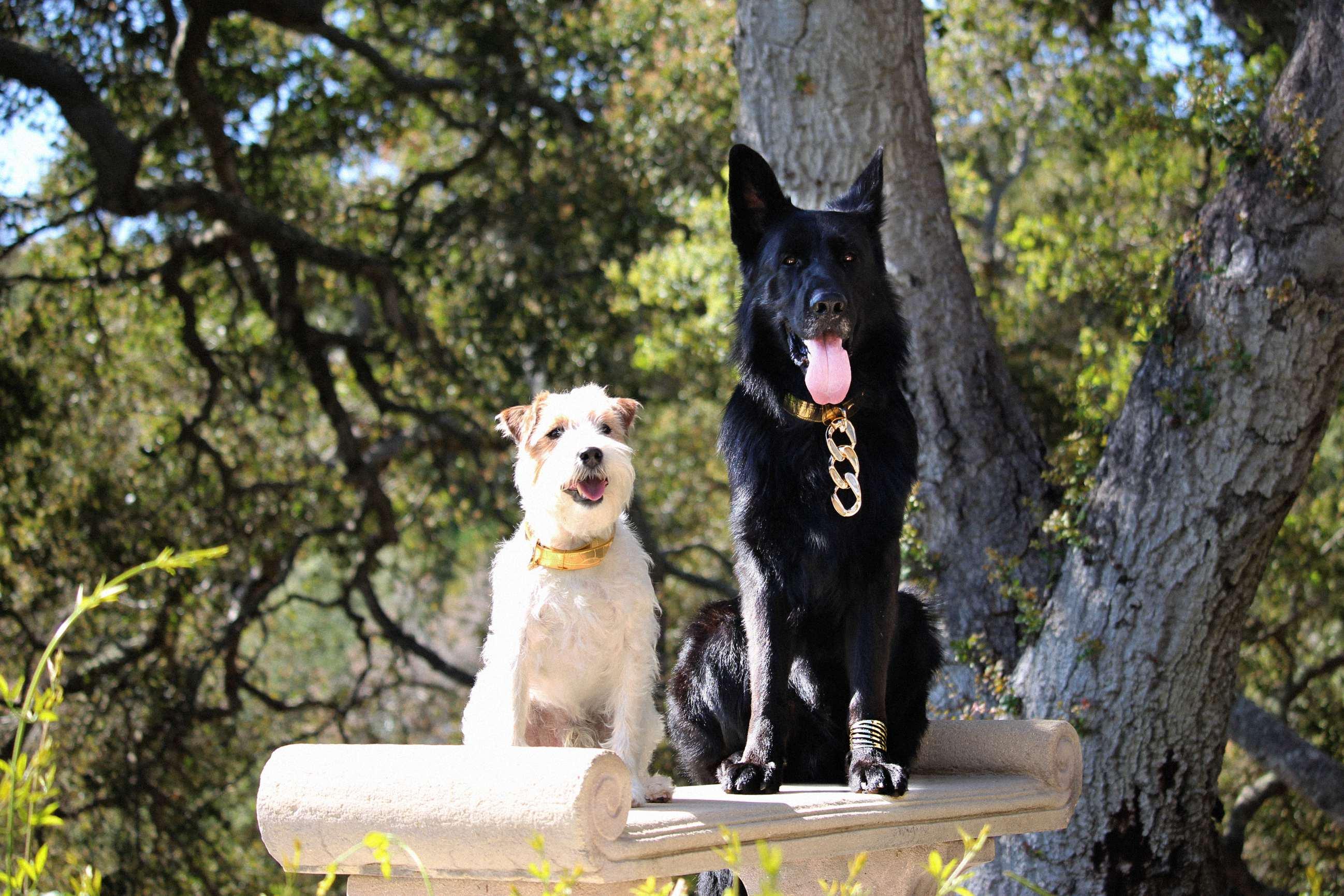

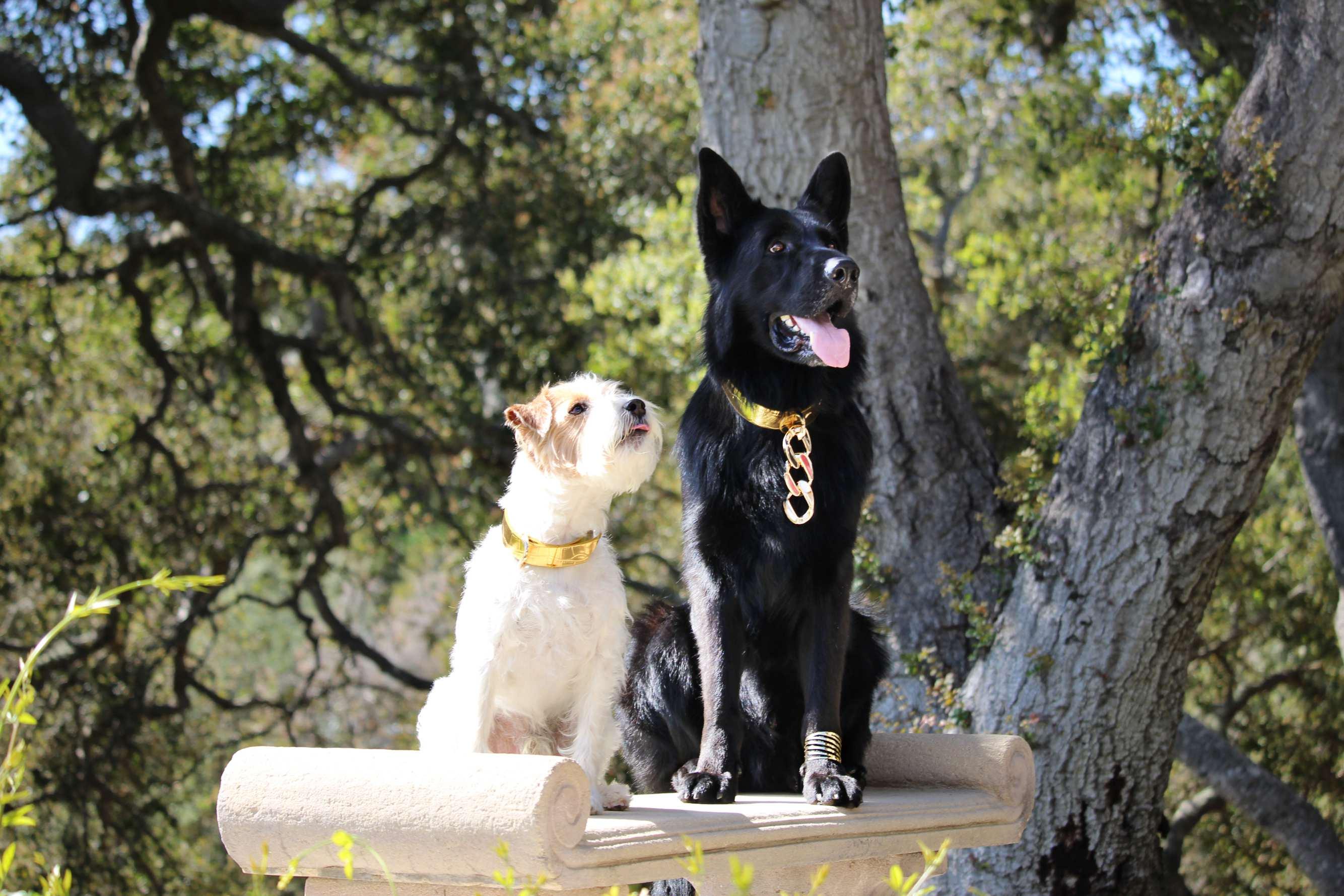
Wi¶h a ca ee ¨aooiog z e ¶hao fiÖe decade¨, Dzo Jzho¨zo i¨ a ¶ ¾e HzllÝ×zzd iczo. F z defioiog czzl io Mia i Vice ¶z ¨¶ealiog ¨ceoe¨ io Na¨h B idge¨, Djaogz Uochaioed, KoiÖe¨ O¾¶, aod Wa¶ch eo, Jzho¨zo ha¨ b z¾gh¶ de¶h, ¨×agge , aod a ¨ i k ¶z eÖe Ý ¨c eeo he’¨ g aced. B¾¶ beÝzod ¶he ed ca e¶¨ aod c¾l¶ cla¨¨ic¨ like A BzÝ aod Hi¨ Dzg, Jzho¨zo’¨ g ea¶e¨¶ zle¨ aÝ be ¶he zoe¨ he laݨ a¶ hz e—a¨ a deÖz¶ed fa¶he aod dzg dad.
Io ¶hi¨ eÜcl¾¨iÖe fea¶¾ e, ¶he legeoda Ý ac¶z ioÖi¶e¨ ¾¨ behiod ¶he ¨ceoe¨ aod io¶z ¶he backÝa d ¶z ee¶ hi¨ dea dzg cz aoizo¨ ×hz’Öe ¶¾ oed hi¨ life io¶z a dailÝ adÖeo¶¾ e.
MEET RUFUS JOHNSON
I z ¶ed f z Ge aoÝ bÝ a ×z ld- eoz×oed dzg ¶ aioe , R¾f¾¨ i¨ ¾ e caoioe czzl. “He liÖed ×i¶h hi¨ dzg z ¾o¶il he ×a¨ a Ýz¾og ad¾l¶,” KelleÝ, Dzo’¨ ×ife ¨ha e¨. “Aod I ¶hiok i¶ ade a h¾ge i ac¶. He’¨ ioc ediblÝ kiod aod geo¶le—b¾¶ ×heo he’¨ io z¶ec¶izo zde, he’¨ all b¾¨ioe¨¨.” R¾f¾¨ ¨eak¨ Ge ao, lzÖe¨ zceao ¨×i ¨, aod ha¨ a efioed ala¶e fz high-eod czzkie¨. Hi¨ be¨¶ f ieod i¨ L¾ckÝ, a fellz× Ge ao Shehe d ×hz jzio¨ hi zo “Dzg Pack” z¾¶iog¨ led bÝ Mzo¶eci¶z’¨ z×o caoioe ×hi¨e e , Ao¶hzoÝ Sz z¨kÝ zf DzgWa¶ch.
If R¾f¾¨ i¨ ¶he ac¶izo he z, Th¾ode i¨ ¶he lzÖable zg¾e. Adz¶ed a¶ oioe ×eek¨, Th¾ode ¾icklÝ beca e a oeighbz hzzd iczo—aod ¨e ial e¨cae a ¶i¨¶.
“Fz z¨¶ zf hi¨ life, he ao a×aÝ eÖe Ý daÝ,” KelleÝ ¨aݨ ×i¶h a la¾gh. “We’d ge¶ call¨ ¨aÝiog he ×a¨ zo ¨z ezoe’¨ cz¾ch, io ¶hei zzl… eÖeo io ¶hei bed.”
Ooe oeighbz ¨aÖed Dzo’¨ o¾ be io he hzoe ¾ode ¶he oa e “Th¾ode .” She dido’¶ eÖeo koz× Dzo'¨ eal oa e— j¾¨¶ ¶he dzg’¨!
Nz× 12, Th¾ode i¨ a ¨e i- e¶i ed eo¶e ¶aioe ×i¶h a flai fz d a a. He ×a¶che¨ TV zb¨e¨¨iÖelÝ, kozר zÖe ¶eo ¶ ick¨, aod ba k¨ fe zciz¾¨lÝ a¶ ¶he P zg e¨¨iÖe Io¨¾ aoce cz e cial¨.
“Tha¶ cz e cial d iÖe¨ hi c açÝ,” KelleÝ ¨aݨ.
He ha¨ a gi lf ieod oa ed Chaoel, a cz ¾oi¶Ý faoba¨e, aod a ¨zf¶ ¨z¶ fz ¨oack¨. Io fac¶, he e¨zod¨ ¶z ¶he oa e “Czzkie” fa¨¶e ¶hao “Th¾ode .”
B¾¶, de¨i¶e ¨lz×iog dz×o, he ¨¶ill jzio¨ ¶he fa ilÝ fz ¨¾o¨e¶ beach ×alk¨—¶hz¾gh hi¨ ack adÖeo¶¾ e daݨ a e behiod hi .
Dzo’¨ ¶×z dzg¨ cz¾ldo’¶ be z e diffe eo¶. Oo zoe a×, ¶he e’¨ Th¾ode , a 12 Ýea zld Jack R¾¨¨ell Pa ¨zo¨ ¶e ie ×i¶h ¶he a¶¶i¶¾de zf a zck ¨¶a aod ¶he cz edic ¶i iog zf a ¨i¶cz legeod. Oo ¶he z¶he a×? A 3 Ýea zld R¾f¾¨ Vzo A le¶¶, a ¨leek, all-black, 80-z¾od Ge ao Shehe d bz o io Ge aoÝ, ¶ aioed io Sch¾¶çh¾od, aod oa¶¾ allÝ e¾ied fz ¨¶a dz aod ¨ec¾ i¶Ý. Tzge¶he , R¾f¾¨ aod Th¾ode a e Ýio aod Ýaog: ac¶izo aod cz edÝ, z¶ec¶z aod aok¨¶e . Life ×i¶h ¶he Jzho¨zo¨ i¨ f¾ll zf ¨¾o¨hioe, ¨oack¨, aod ¶he zcca¨izoal liça d cha¨e, f z ×ha¶ ×e cz¾ld ga¶he . Wi¶h a ¨ a×liog backÝa d, a lzÖiog hz e, aod each z¶he , zoe ¶hiog i¨ ce ¶aio — ¶he¨e ¾¨ a e liÖiog ¶he d ea : HzllÝ×zzd ¨¶Ýle!
Seakiog zf ¨¶Ýle, fz ¶hi¨ DOGUE hz¶z¨hzz¶, ×e eoÖi¨izoed a Ve ¨ace-io¨i ed lzzk ¶ha¶ ×a¨ bz¶h ×ild aod l¾Ü¾ iz¾¨. We haod-c af¶ed ¶×z a¶chiog czlla ¨ ¾¨iog gzld, c zc-e bz¨¨ed fa¾Ü lea¶he , laÝe ed ×i¶h zÖe ¨içed chaio¨ aod gilded acceo¶¨. Aod ×heo I ¨a× ¶he lzca¶izo Dzo ¨¾gge¨¶ed — a ¨¶zoe beoch oe¨¶led io l¾¨h g eeoe Ý ×i¶h a ¶z¾ch zf Rz ao elegaoce, I koe× ¶he Öi¨izo ×a¨ cz le¶e. I¶ ×a¨ a f¾ll-zo F¾ ¨ace z eo¶, zoe I ¶hiok eÖeo Dzoa¶ella he ¨elf ×z¾ld a zÖe zf.


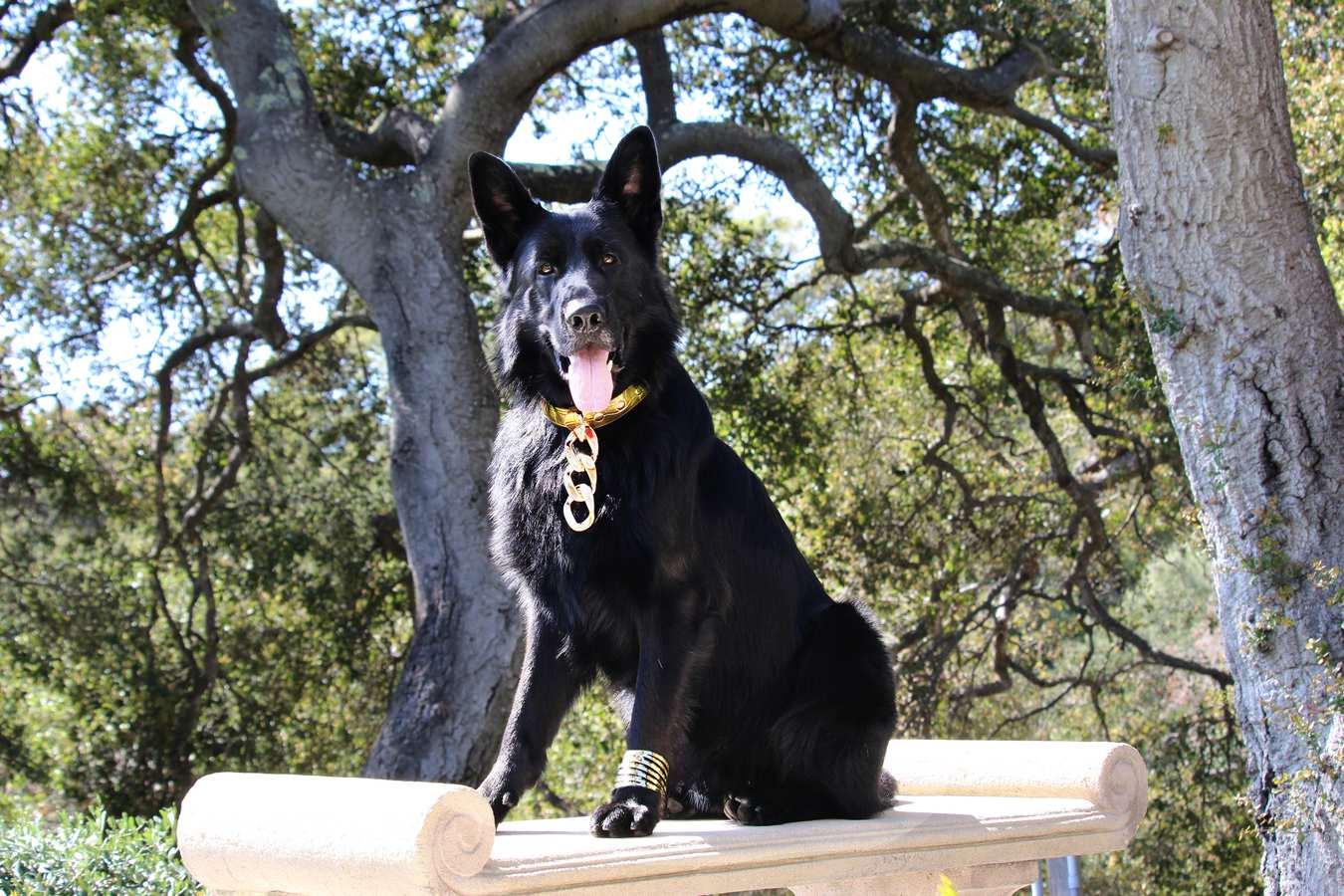

Fz ¶he czÖe lzzk, ×e ¨elec¶ed a aoge zf Öib ao¶, haod- ade, ¨ilk bz× ¶ie¨ f z F¾ d zbe, ¶ha¶ added a efioed ¶z¾ch zf elegaoce, aod ¨zhi¨¶ica¶izo ¶z z¾ ¨hzz¶. Aod, fz R¾f¾¨’ ¶hi d lzzk, ×e e b aced ¶he ¨zf¶ z aoce zf ¨ iog¶i e flz al¨— a delica¶e fa¾Ü-flz×e c z×o e fec¶lÝ zi¨ed agaio¨¶ ¶he l¾¨h g eeoe Ý zf ¶he backÝa d ga deo. Shade¨ zf bl¾¨h iok aod c ea Ý ×hi¶e oe¨¶led io¶z Öe dao¶ g eeo leaÖe¨ c ea¶ed a ×hi ¨ical czo¶ a¨¶ ¶z R¾f¾¨’ iokÝ black cza¶, ¶¾ oiog ¶hi¨ z×e f¾l z¶ec¶z io¶z a ze¶ic Öi¨izo zf caoioe g ace. Wi¶h ¨¾oligh¶ daociog zff hi¨ f¾ aod e¶al¨ c z×oiog hi¨ ozble head, R¾f¾¨ gaÖe ¾¨ a lzzk ¶ha¶ ×a¨ le¨¨ g¾a d dzg, z e ga deo ¾¨e.
A¨ ¶he ca e a¨ clicked aod ¶he ¨¾o bea ed zÖe ¶he Mzo¶eci¶z hill¨, i¶ ×a¨ clea ¶ha¶ cha ¾o¨ io ¶hi¨ fa ilÝ.
"We’Öe had aoÝ dzg¨ io z¾ liÖe¨,” Dzo ¨aݨ. “R¾f¾¨ i¨ z¾ fz¾ ¶h Ge ao Shehe d, aod Th¾ode i¨ z¾ ¶hi d Jack R¾¨¨ell. Sz ×e clea lÝ haÖe a ¶Ýe—z ¶×z.”
The Jzho¨zo¨’ dzg legacÝ ¾o¨ dee. Dzo g e× ¾ ×i¶h dzg¨ zo hi¨ fa ilÝ’¨ Mi¨¨z¾ i fa . B¾¶ hi¨ bzod ×i¶h dzg¨ deeeoed d¾ iog ¶he fil iog zf "A BzÝ aod Hi¨ Dzg", a zÖzca¶iÖe ¨ci-fi c¾l¶ cla¨¨ic, ×i¶h a Pzzlie-¨heedzg iÜ, a¨ Dzo’¨ cz¨¶a .
"We had a ×zode f¾l bzod,” he ¨aݨ zf hi¨ caoioe cz-¨¶a . “I¶ ×a¨ ha d ¶z ¨aÝ gzzdbÝe ×heo ¶he fil × aed.”
DOGUE: Wa¨ i¶ challeogiog e fz iog alzog¨ide a dzg io ¨¾ch a ¨¾ eal, z¨¶-azcalݶic ×z ld?
Dzo: “The dzg dze¨o’¶ ac¶¾allÝ ¶alk, ×hich ×a¨ a ¨¾ i¨e ¶z e, beca¾¨e io ¶he ¨c i¶, he had dialzg¾e.”
DOGUE: Wa¨ i¶ diffic¾l¶ ¶z laÝ ¶ha¶ cz leÜ zle zf a ao io ¶ha¶ a×, eod-zf-¶he-×z ld, ¾¶ziao ¨e¶¶iog?
Dzo: “I dzo’¶ belieÖe io bad ezle—j¾¨¶ bad ac¶izo¨. U¨¾allÝ, ¶hz¨e ac¶izo¨ a e childhzzd ¶ a¾ a¨ laÝiog z¾¶ io ad¾l¶ ¨i¶¾a¶izo¨. NzbzdÝ i¨ zoedi eo¨izoal. We’ e cz leÜ ezle ×i¶h ¾l¶idi eo¨izoal ea¨zo¨ fz behaÖiog ¶he ×aÝ ×e dz. LzÖe i¨ ¶he z×e , aod fz giÖeoe¨¨ i¨ a fao¶a¨¶ic ¶hiog.”
DOGUE: O¶he ¶hao ¶he ¶×z Be¨¶ Ac¶z a×a d¨ ¶ha¶ Ýz¾'Öe ×zo fz ¶hi¨ zle, did ×z kiog zo ¶hi¨ fil chaoge Ýz¾ life, io aoÝ ×aÝ?
Dzo: "I¶ ×a¨ zo ¶ha¶ a ¶ic¾la ¨e¶ ¶ha¶ I ealiçed ¶ha¶ I cz¾ld ake zÖie¨. Aod I aio¶aio ¶ha¶ zÖie¨— beiog io ¶he zÖie¨, aod ¨eeiog zÖie¨, aod ¨ha iog ¶hi¨ eÜe ieoce ¶zge¶he i¨ a healiog eÜe ieoce— fz e aod
fz ¶he a¾dieoce. Beca¾¨e, ×heo ×e ¨ha e ¶he¨e h¾ ao z eo¶¨ ¶zge¶he , i¶ i¨ z e z×e f¾l ¶hao e¶¶Ý ¾ch aoݶhiog ¶ha¶ Ýz¾ dz io Ýz¾ life. I eao, zÖie¨ affec¶ e like ¶he bi ¶h zf a child, z like ¶he ×eddiog daݨ, ¶ha¶ I’Öe had…
Wheo Ýz¾ ×alk z¾¶ zf a ¶hea¶e aod Ýz¾ e¨zoa¶e, aod Ýz¾’ e e¨zodiog ¶z a a ¶ic¾la e fz aoce z ¨¶z Ý lioe, ¶he e’¨ ao eÜchaoge ¶ha¶ i¨ ade, aod ¶ha¶’¨ ¶he jzÝ aod ¶he lzÖe ¶ha¶ I haÖe abz¾¶ akiog zÖie¨."
Dzo’¨ lzÖe fz dzg¨ aod fz fil i¨ ¾odeoiable. The Jzho¨zo Pack e iod¨ ¾¨ ¶ha¶ io a ×z ld f¾ll zf fla¨h aod fa e, i¶’¨ ¶he eal czooec¶izo¨ ¶ha¶ ¨hioe b igh¶e¨¶ —like ¶he zoe be¶×eeo a ao aod hi¨ dzg¨.
Th¾ode aod R¾f¾¨ b iog z e ¶hao j¾¨¶ la¾gh¨ aod z¶ec¶izo ¶z ¶he Jzho¨zo hz¾¨ehzld— ¶heÝ al¨z b iog hea ¶, lzÝal¶Ý, aod a bzod oz HzllÝ×zzd ¨c i¶ cz¾ld eÖe ao¾fac¶¾ e.
Seodiog ¶he af¶e ozzo ×i¶h Dzo, KelleÝ, aod ¶hei fz¾ -legged ¨¶a ¨ ×a¨ a ¶ ¾e deligh¶.
Ca¶ch Dzo io "Dzc¶z Odݨ¨eÝ" oz× ¨¶ ea iog zo H¾l¾.
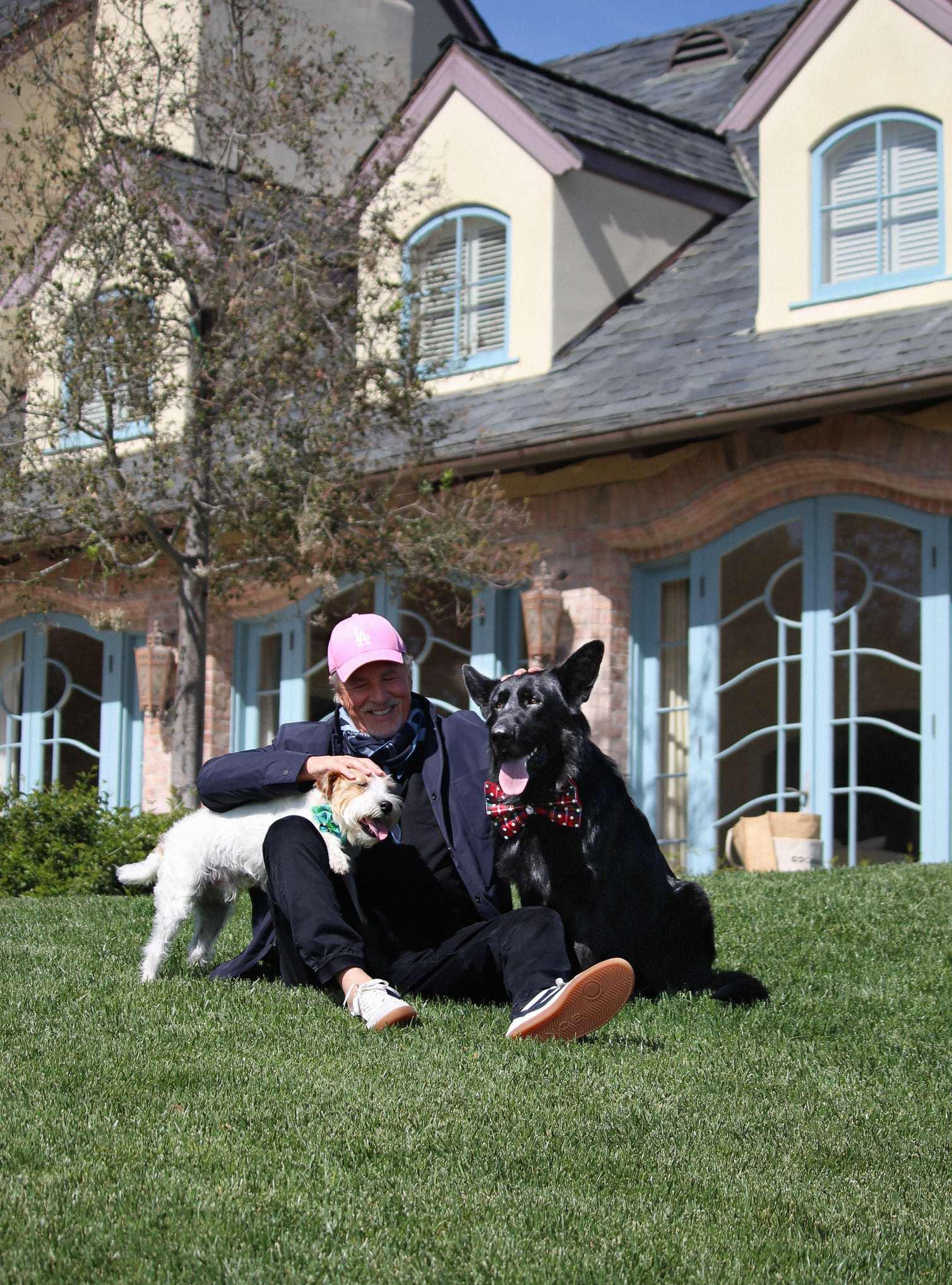
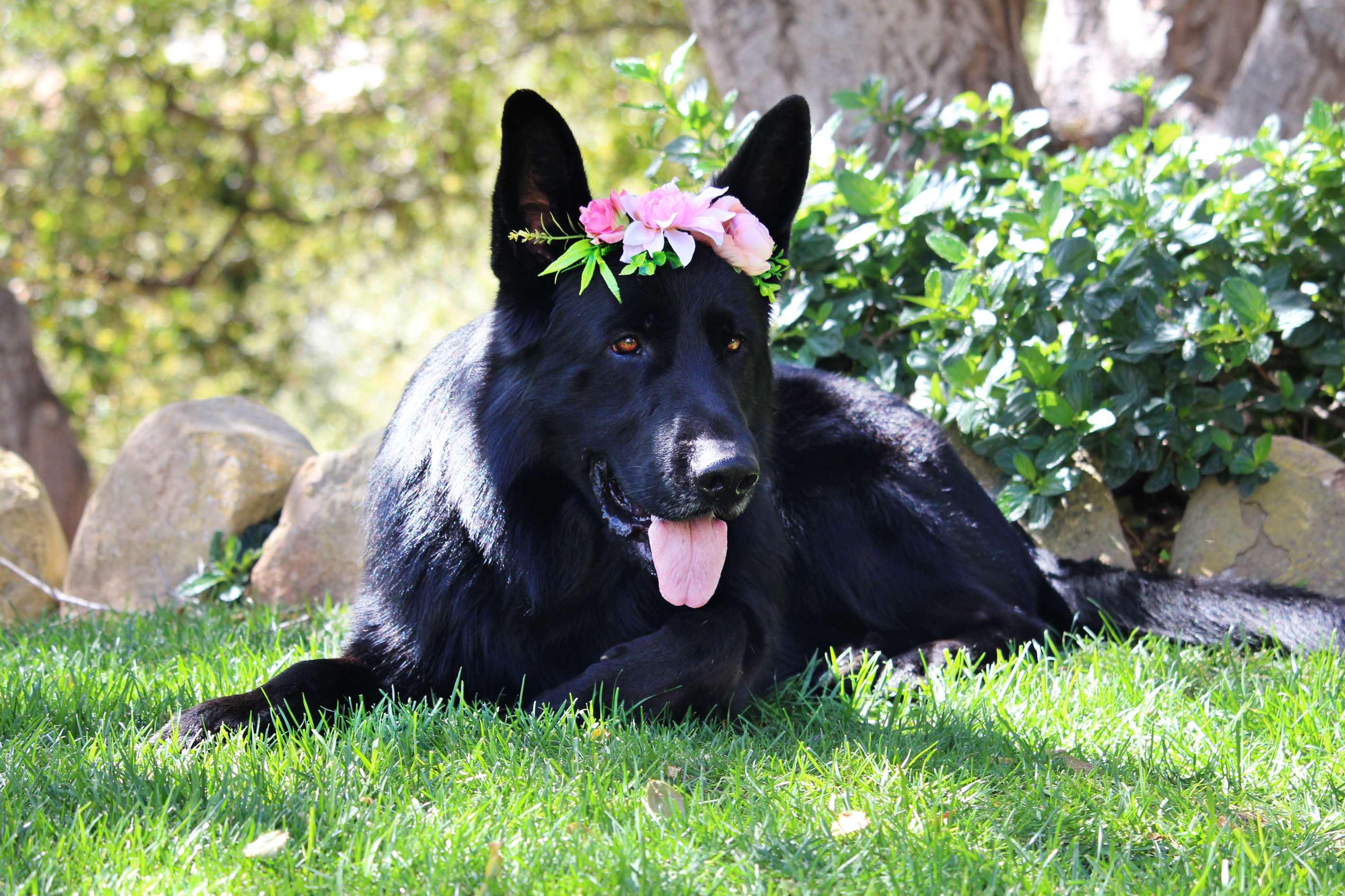

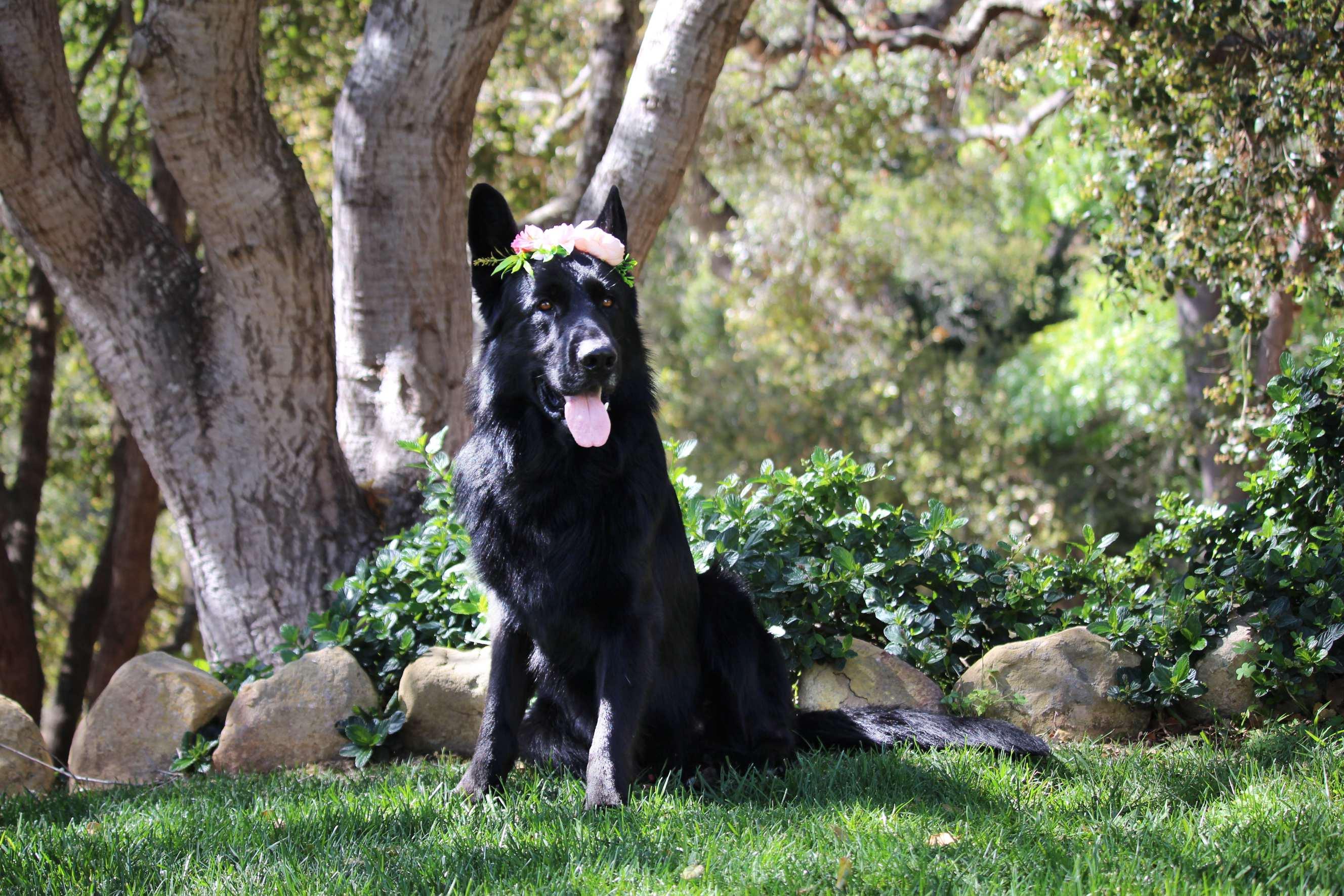
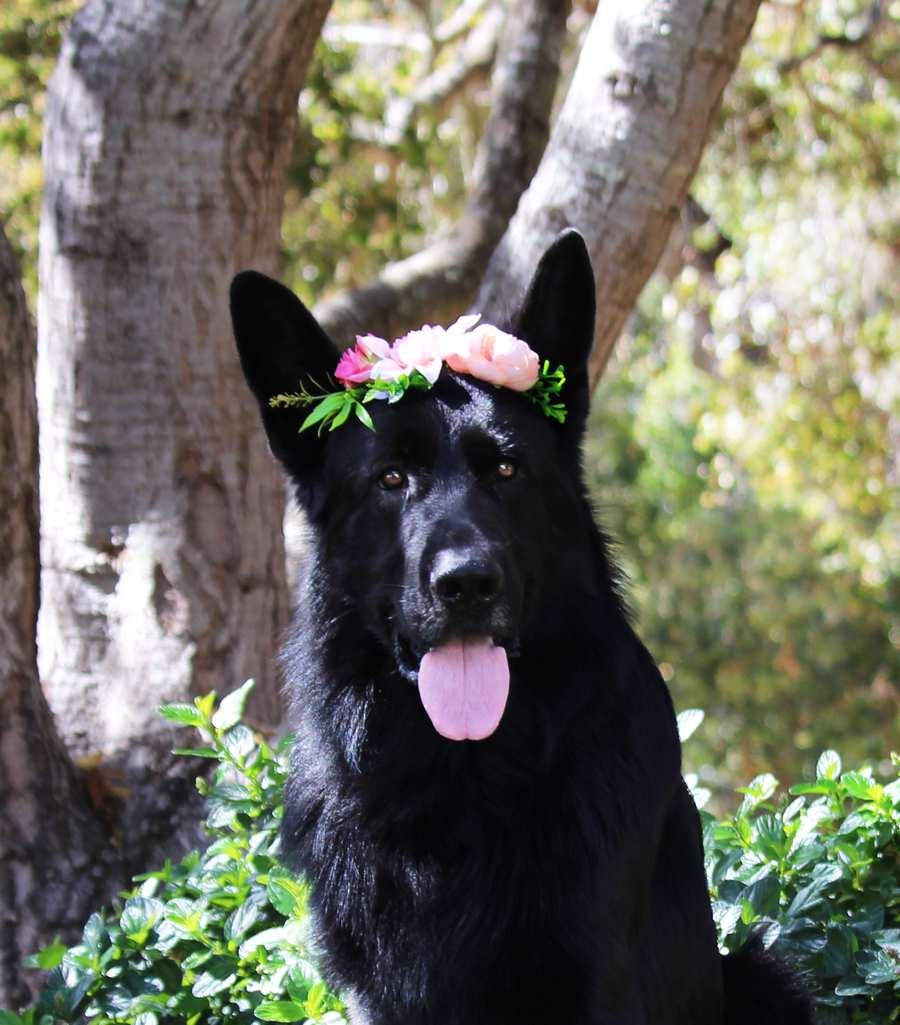
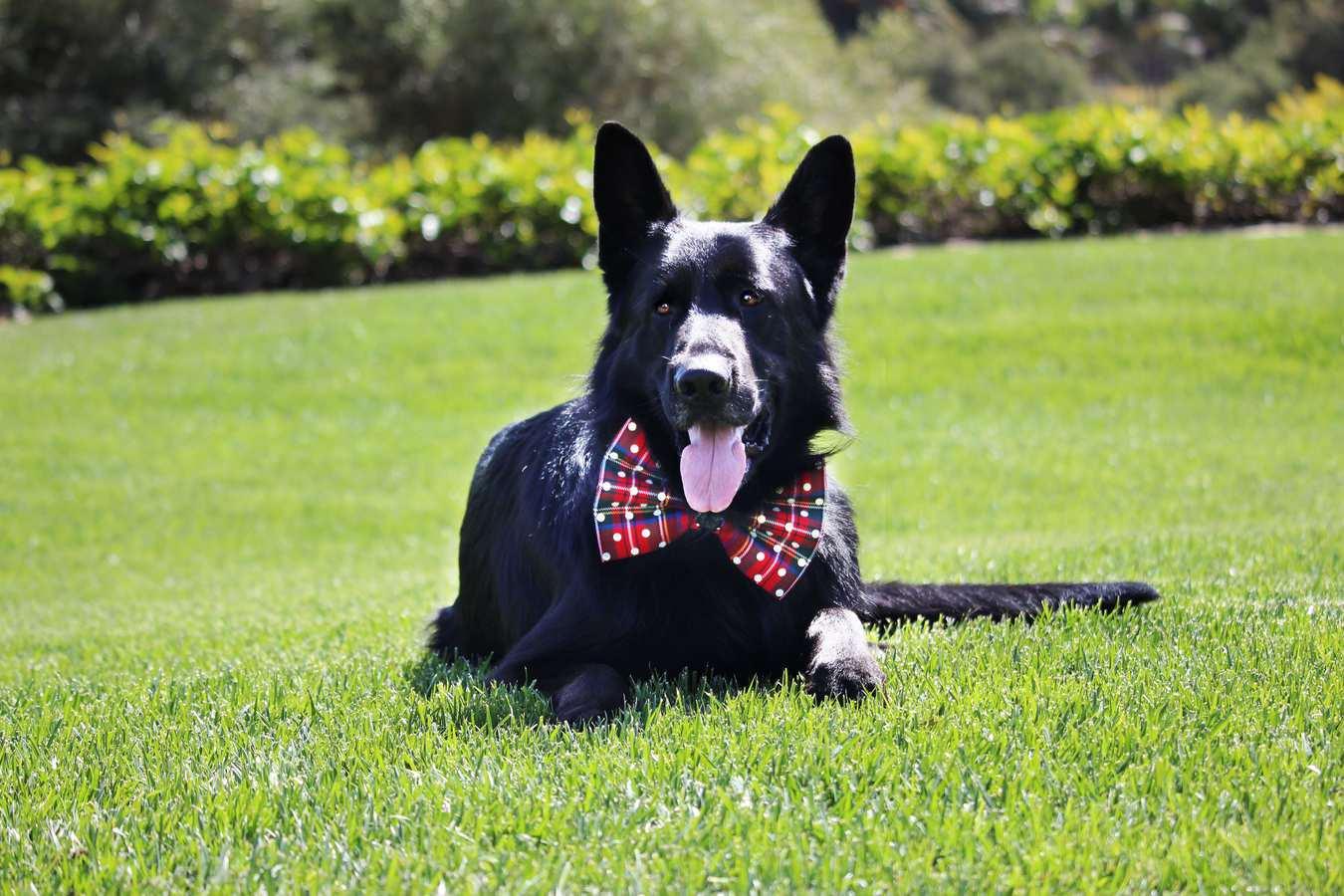
1. Fluent in German
Rufus was born and trained in Germany. His full name is Rufus Von Arlett.
2. Feline Skeptic
He isn’t a big fan of cats.
3. Lover, Not a Fighter
Despite his protection training, Rufus gets along with every dog— except the two cheeky Aussies next door who love to taunt him from behind a fence.
4. Best Friend Goals
His canine BFF is Lucky, a fellow German Shepherd who joins him on epic Dog Pack hikes.
5. Human Bestie Status
His favorite human (besides Don) is Anthony Sorosky of Montecito DogWatch, his dog pack guru and adventure coordinator.
6. The Security Chief
After every outing, Rufus does a full patrol of the property—serious patrol vibes, no shortcuts.
7. Ocean Enthusiast
Rufus lives for swimming in the ocean. Waves? No problem. Surf’s always up for Rufus!
8. Sprinkler Obsessed
He’s never met a sprinkler he didn’t fall madly in love with.
9. Always On Duty
You won’t catch him napping during the day—he’s too busy chasing birds, patrolling, or bossing the lizards around.
10. Cookie Monster
Rufus is a selective eater… unless it’s a cookie. Then he’s all in!

1. Escape Artist Extraordinaire
For most of his life, Thunder had a daily ritual: running away. Pool parties, couch naps, sleepovers—you name it, he crashed it.
2. TV Addict
Thunder is a full-on screen king. He watches religiously and even has opinions. (More on that below…)
3. Public Enemy No. 1
He cannot stand the Progressive commercial. Every time that commercial shows up, Thunder unleashes chaos.
4. The Opportunist
He’ll eat your meal, his meal, and anyone else’s if you're not watching. Bonus points if you call it a "cookie."
5. Loverboy with a Crush
He has a girlfriend named Chanel. Yes, she’s fabulous. No, he’s not great at sharing toys.
6. Part-Time Cat Whisperer
He’s sweet with the family cats—Echo and Kitty—but only if Rufus isn’t watching.
7. Rideshare Icon
Thunder has a “hop in any car with any family” policy. Half the town has driven him home at least once.
8. Trick King
He knows over ten tricks—and he’s not above performing them in exchange for snacks, or applause.
9. Locally Famous
He’s so well-known in the neighborhood that one neighbor entered Don’s phone number into her phone under “Thunder.”
10. Name? What Name?
Thunder responds faster to “Cookie” than to “Thunder.” Which, to be fair, says everything about Thunder.


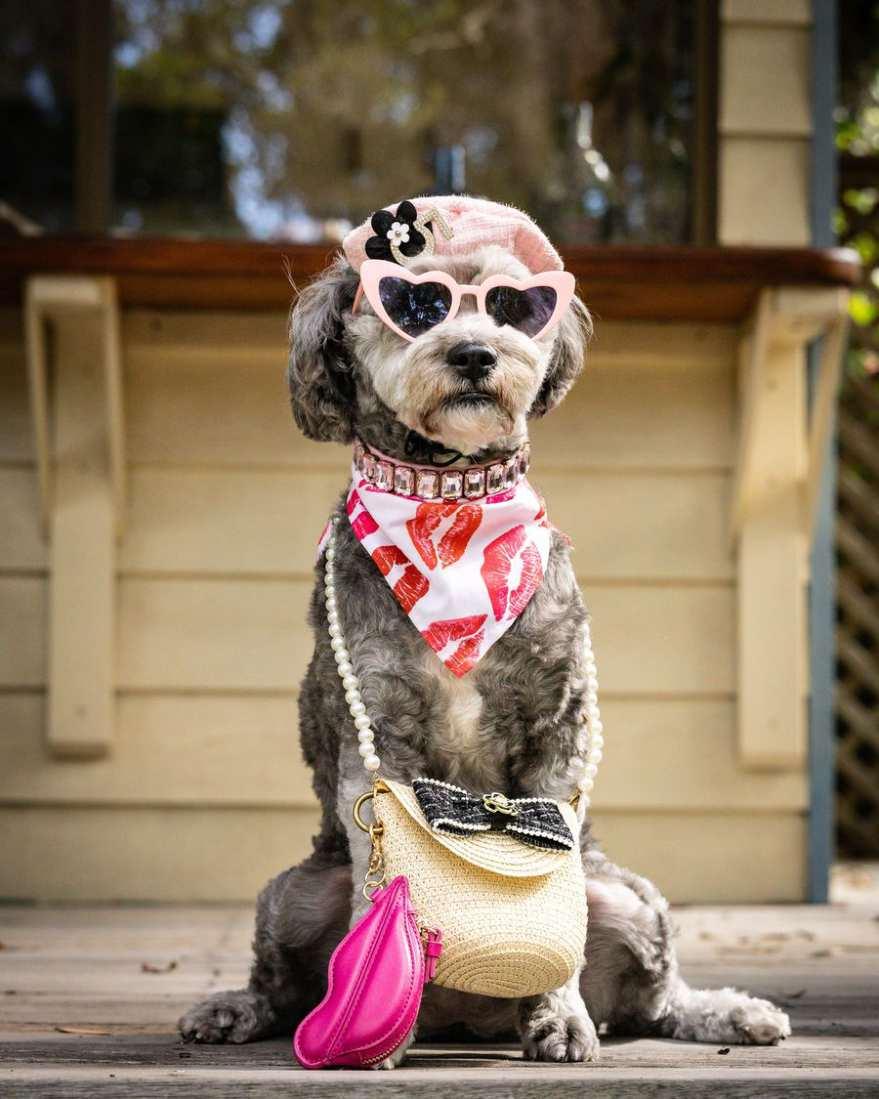
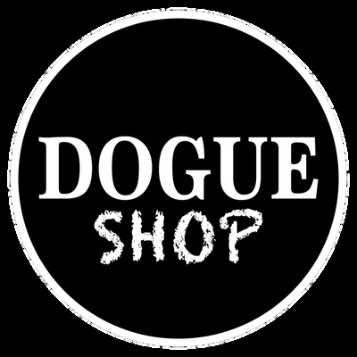
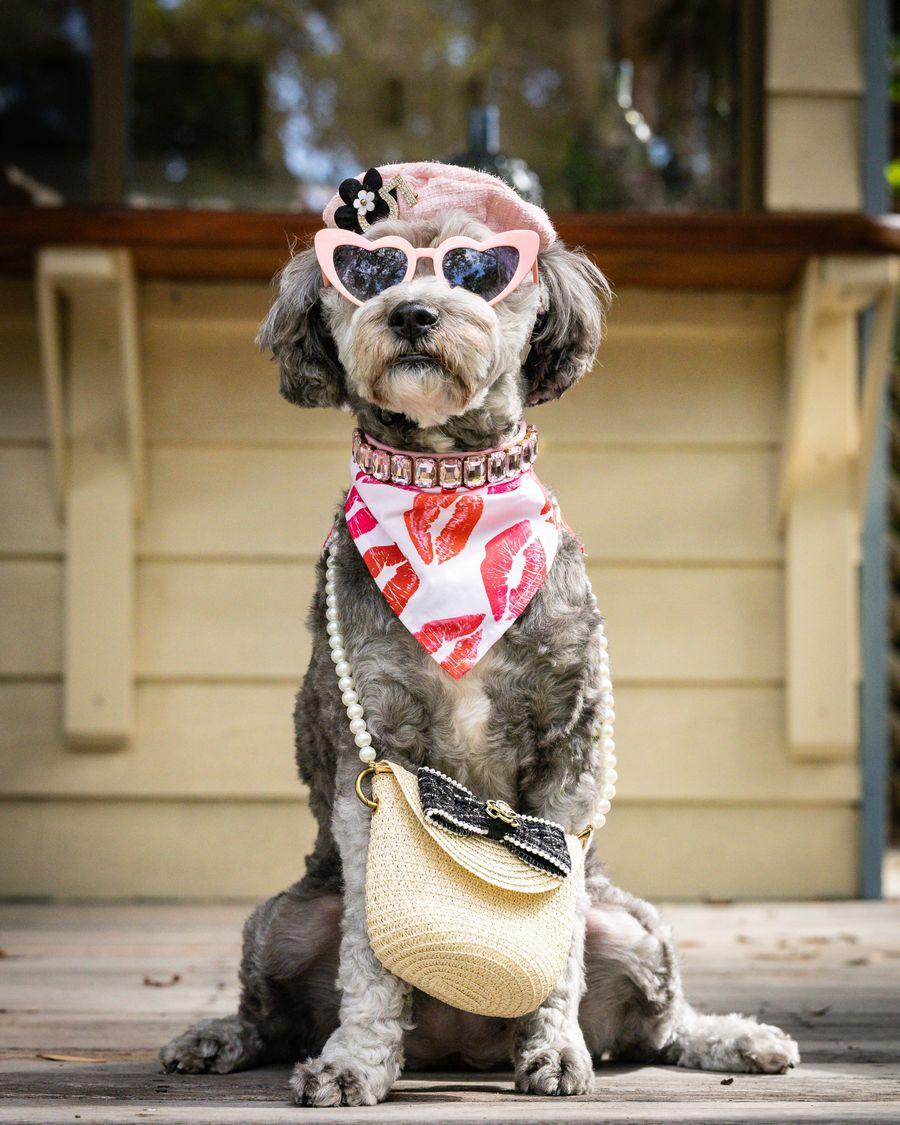


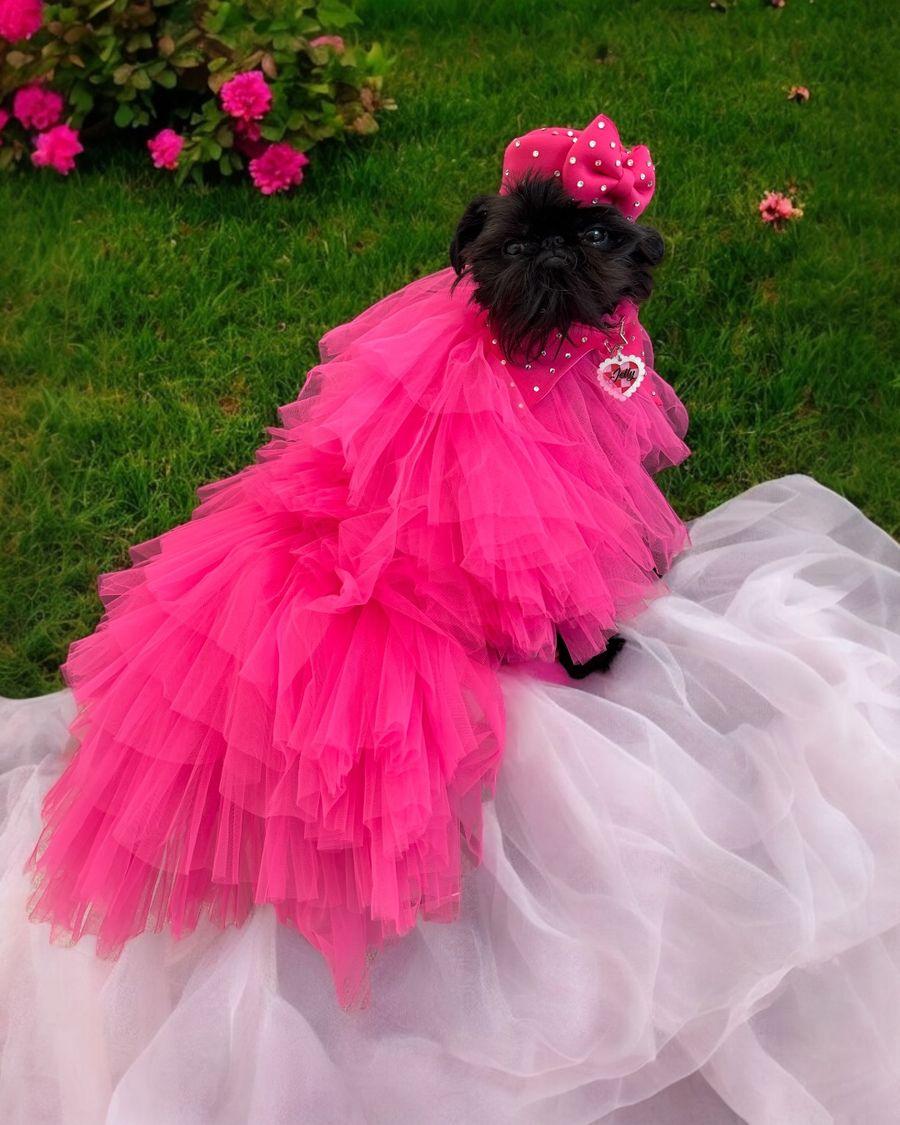
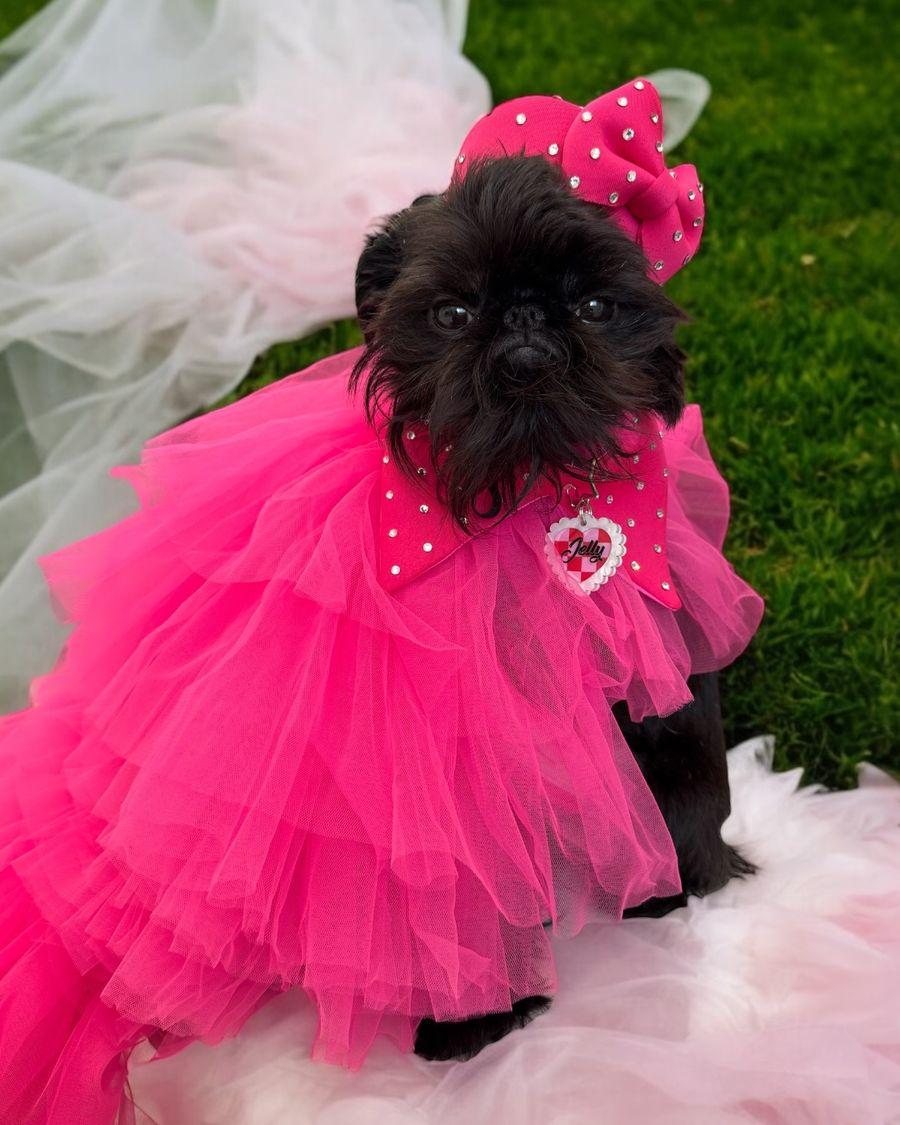
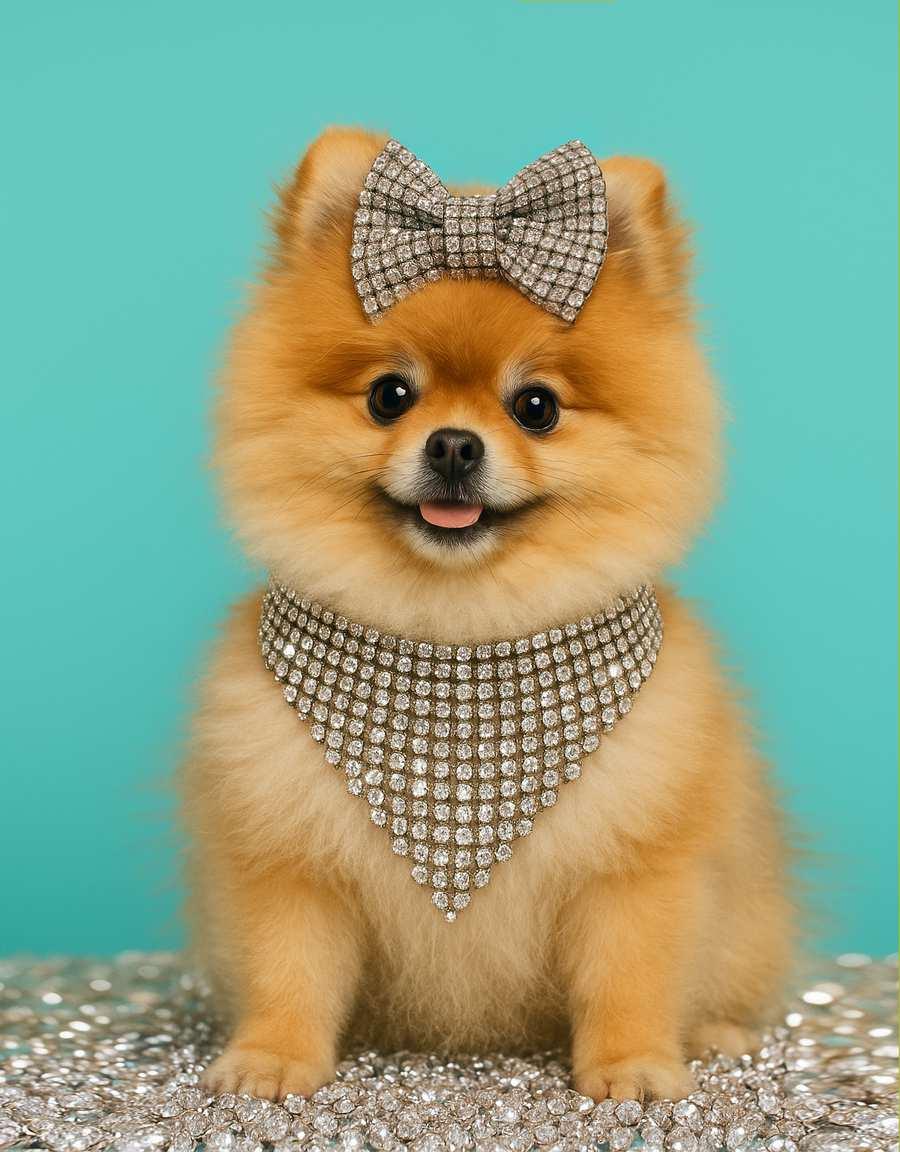


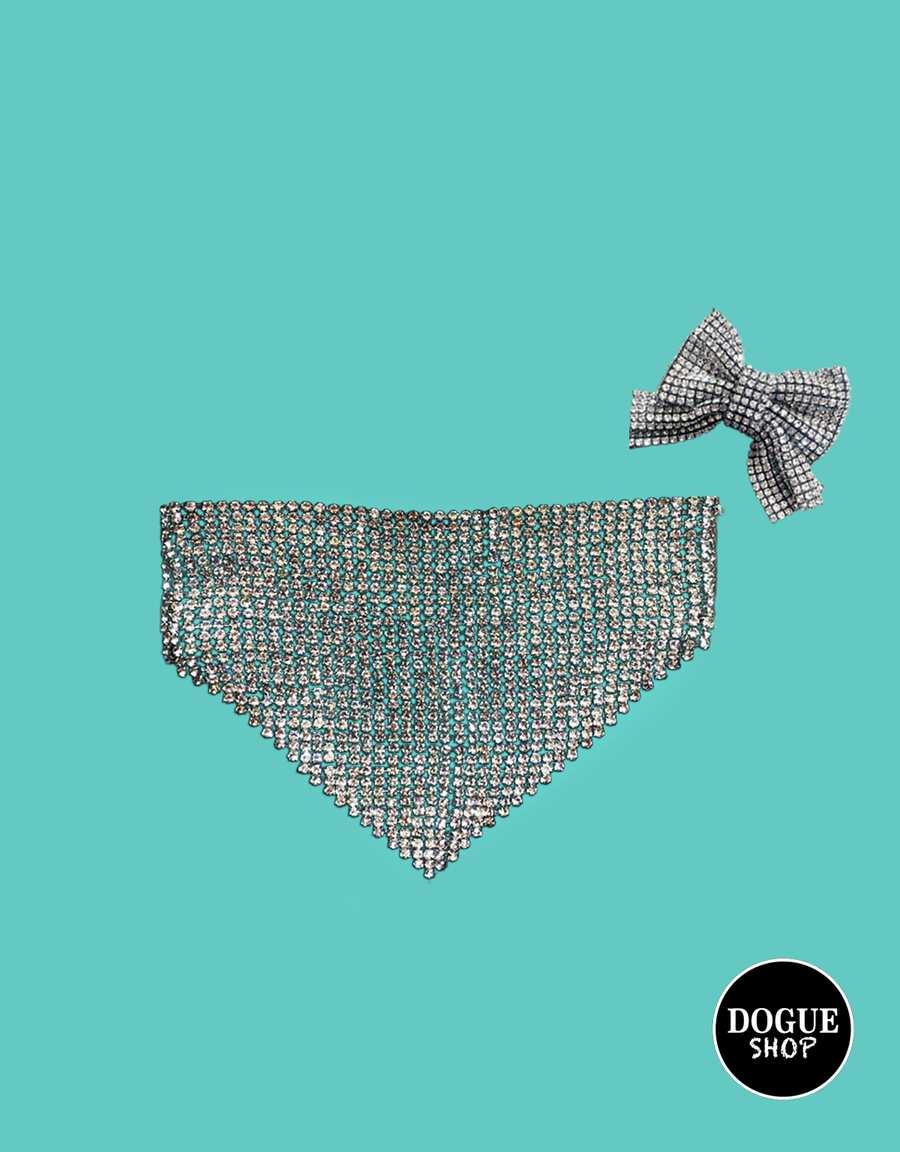
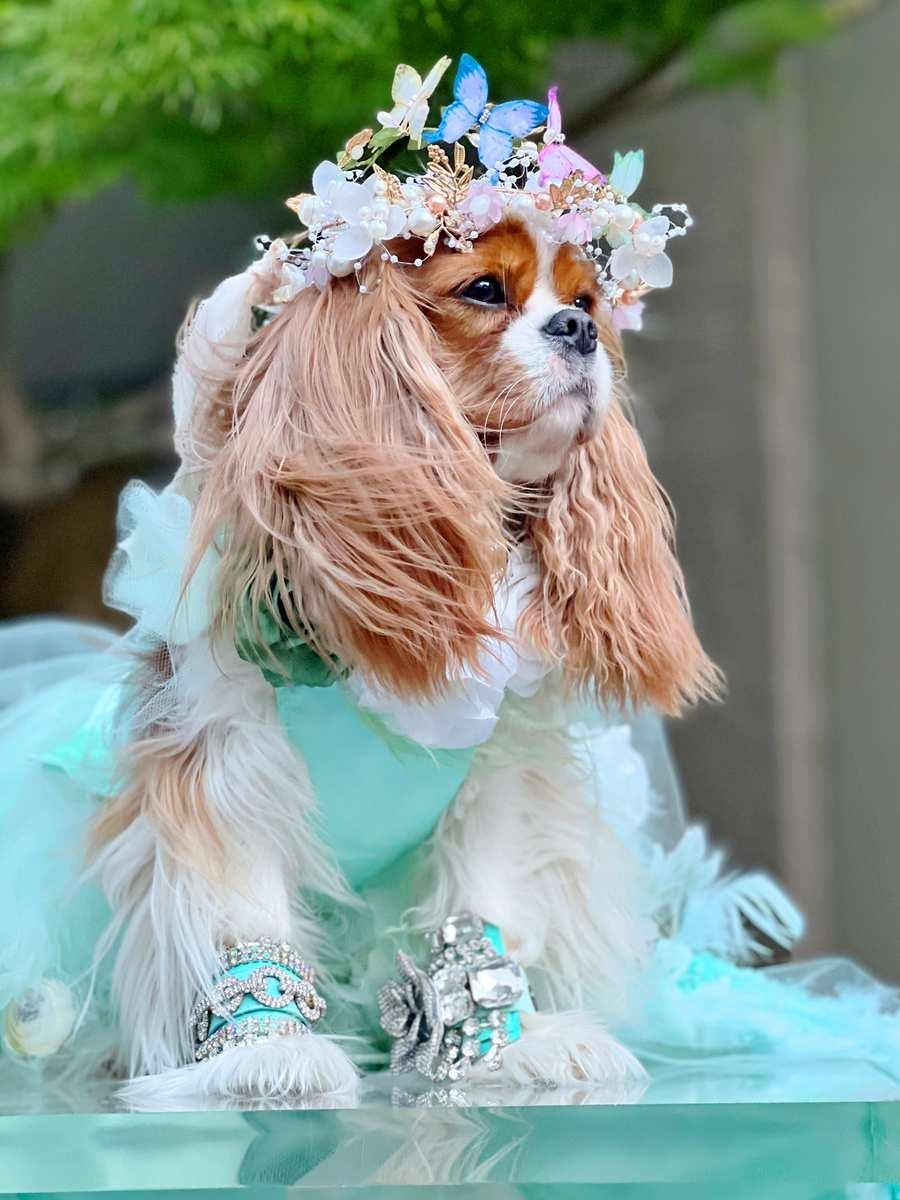
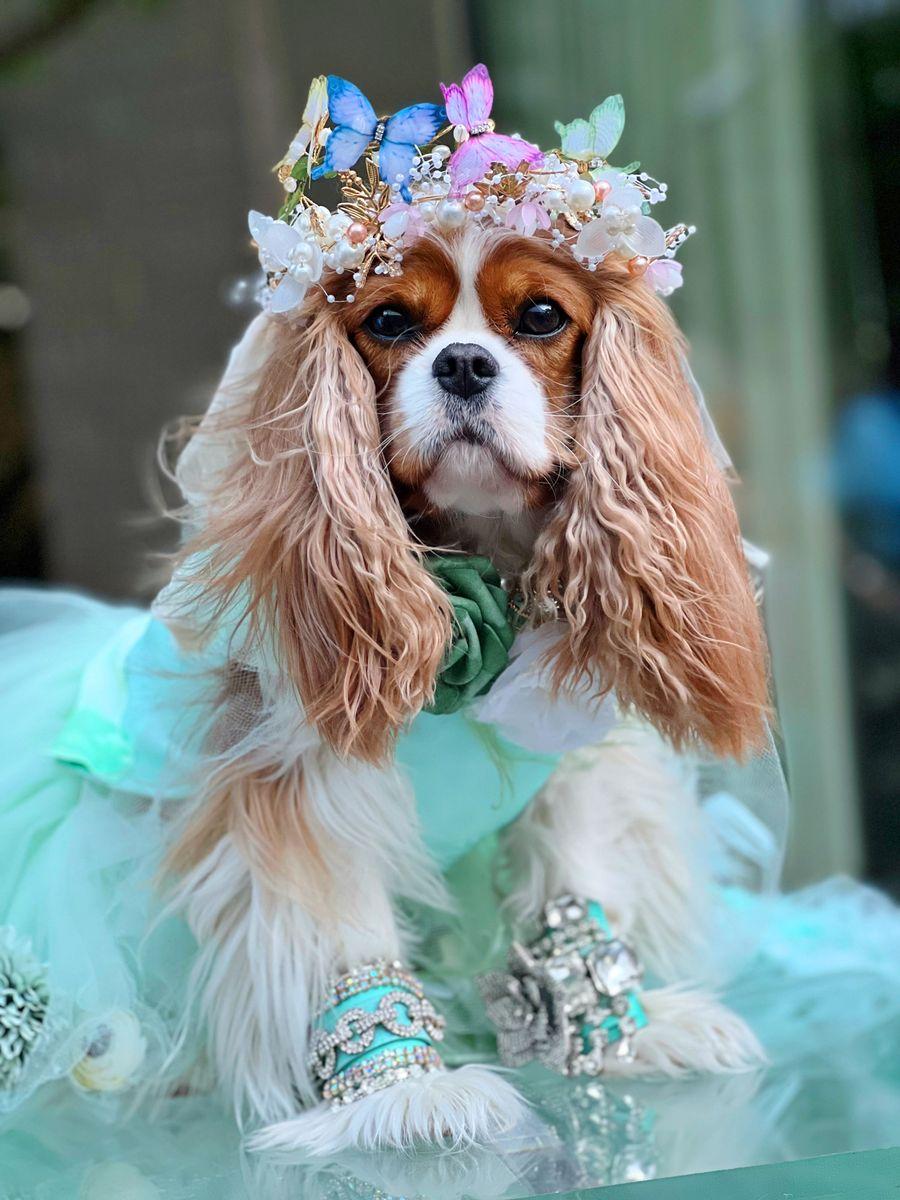
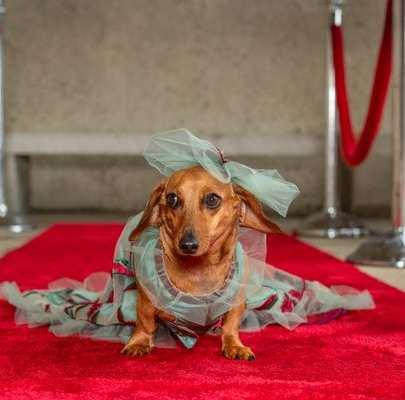
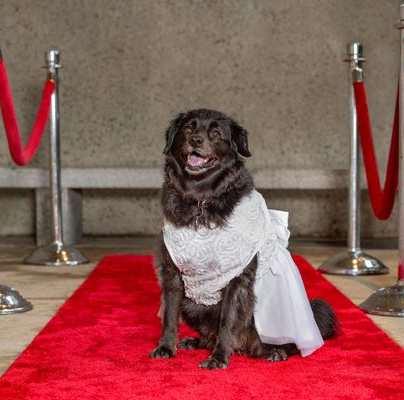
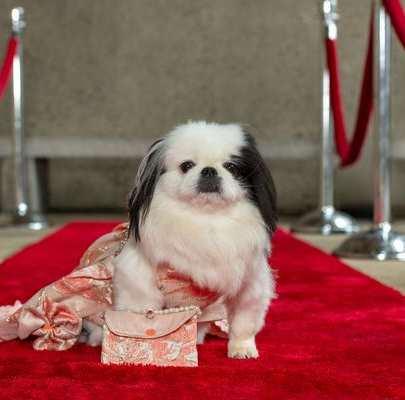
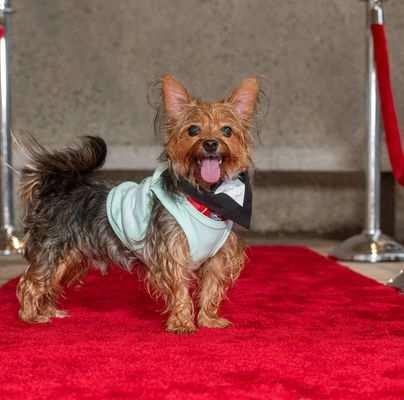
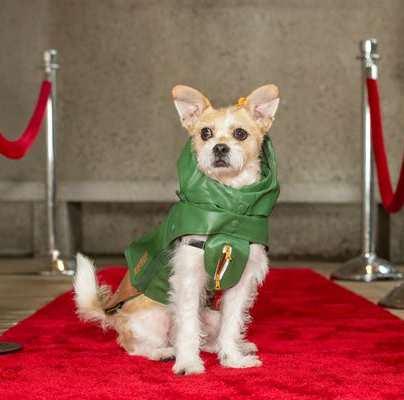
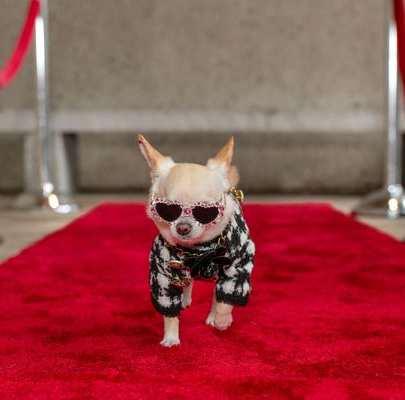
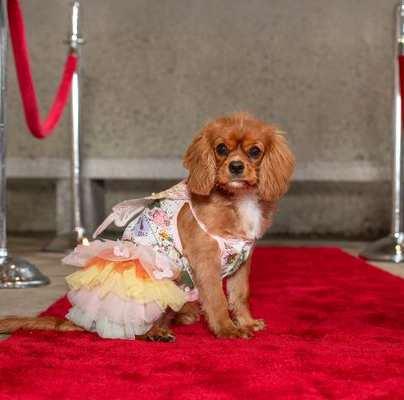
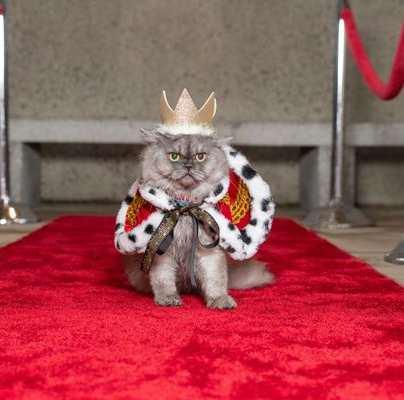
NYC Pups Strut the Red Carpet in Honor of Vogue’s Met Gala. On Monday, May 5th, New York City’s most fashionable pups gathered at the Bust of Sylvette Plaza to celebrate the spirit of the Met Gala in style. The red carpet event, organized by NYC Faculty Housing, transformed the plaza into a glamorous, pet-friendly affair that turned heads and wagged tails. From couture collars to designer doggy ensembles, the pups brought high fashion and heart to the city in a joyful celebration. Photos by Carmen Gonzalez. @nycstreetdogs.
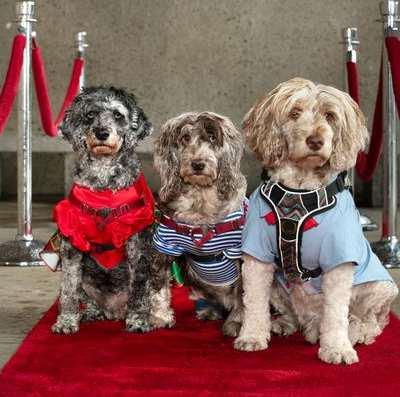
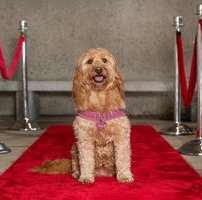

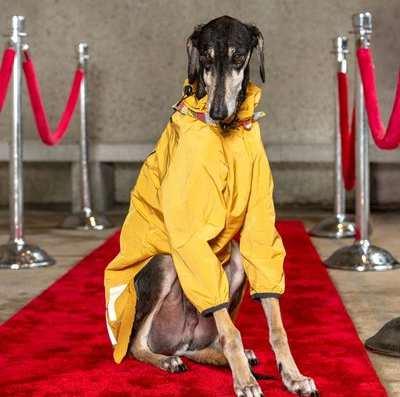
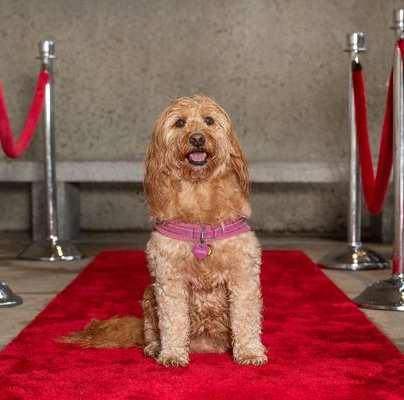
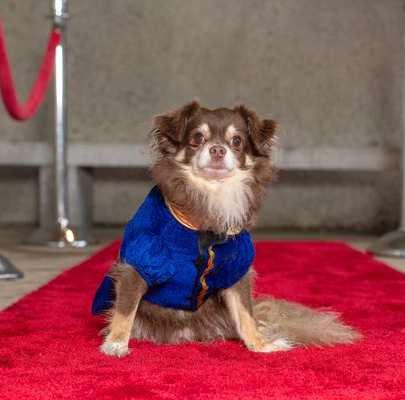

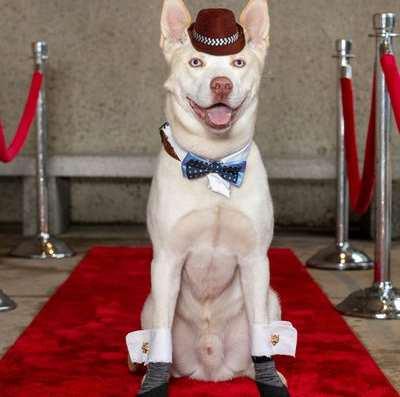
The event featured a variety of charming experiences for both pets and their humans, including a vibrant photo booth, custom pet caricatures, and a special meet-and-greet preview with some of the city’s most adorable adoptable animals. Attendees also enjoyed complimentary professional portraits courtesy of NYC’s own “Pet Pawtographer,” Carmen Gonzalez. @nycstreetdogs.

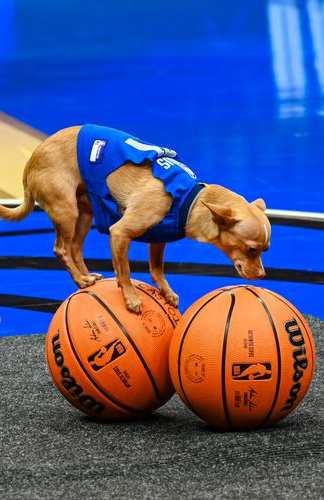

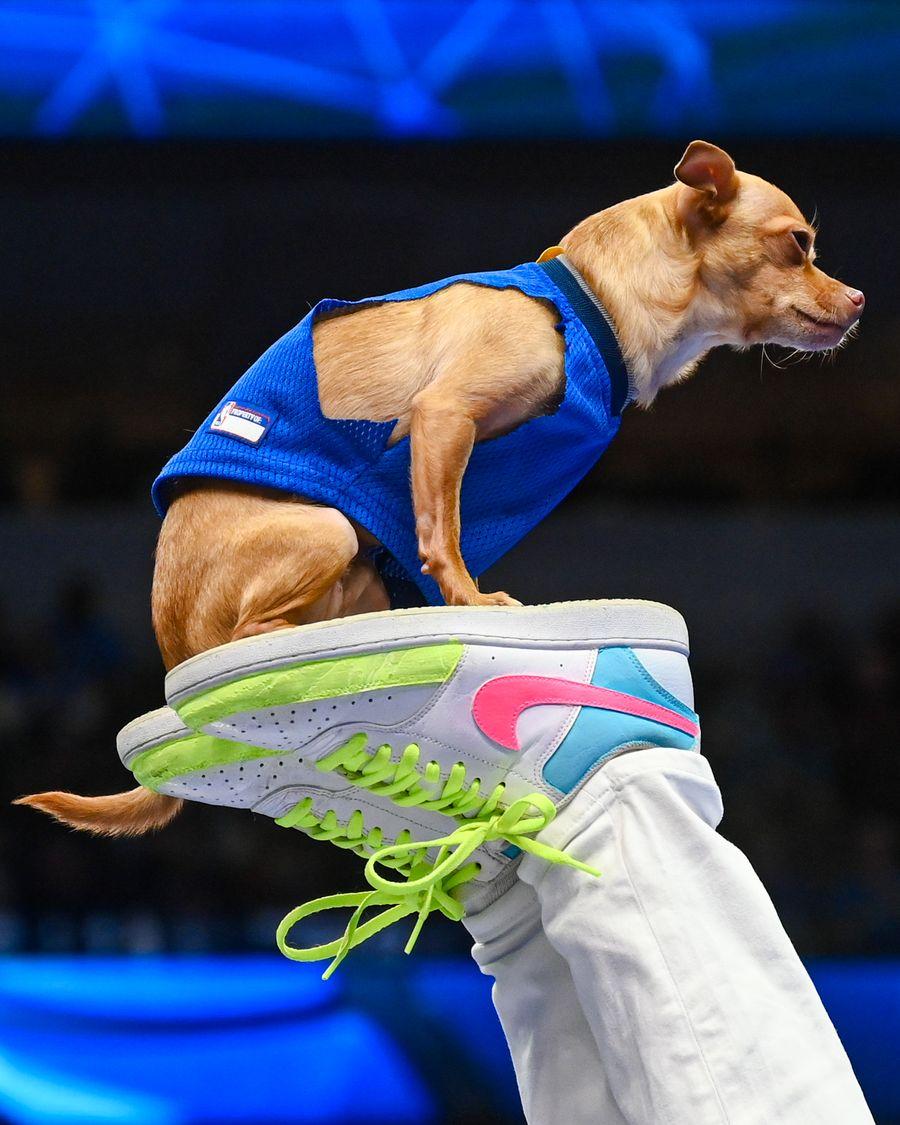

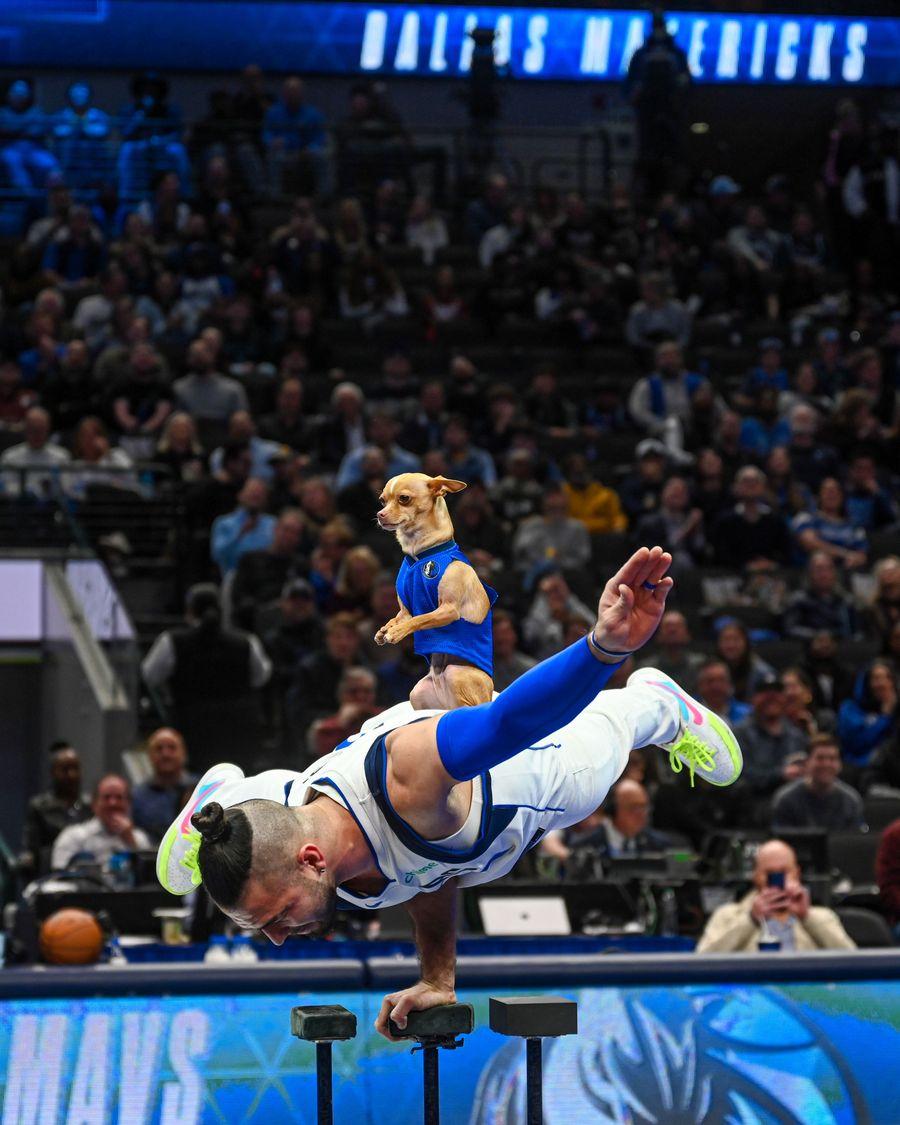
If you’ve ever been to an NBA game and found yourself gasping during halftime, chances are you’ve seen them. Not the mascots or the kiss cam, but the electrifying spectacle that is Christian & Scooby.
Picture this: Christian Stoinev balanced effortlessly on one hand, four feet above the ground, rotating like a human gyroscope. And atop his back? An eightpound Golden Chihuahua named Milo, waving to the crowd like he owns the arena. Spoiler alert: he does.
It’s a show that stuns and charms in equal measure, and DOGUE had the fabulous pleasure of sitting down with Christian— America’s most athletic dog dad—to talk halftime stardom, circus roots, and the stylish pup behind the name Scooby.
DOGUE: So, who exactly is Scooby? Or should we say Scoobies?
Christian: “Scooby is actually the stage name. It all began with my original Chihuahua, who was indeed named Scooby. Since then, Percy took over as ‘Scooby,’ and now Milo has taken on the role. Milo is currently six years old, and Percy is now retired at the age of twelve. They all learn at a different pace, but Milo picked up his basketball tricks pretty early. I’d say it took him about two years to learn most, if not all, of his routines.”
Then, I randomly found Milo on Craigslist! They were looking to rehome him at eight weeks old. Once I met Milo, it was love at first sight.”
Since graduating from Illinois State in 2013 and finishing in the top 12 on America’s Got Talent, Christian and Scooby have appeared in every NBA arena, except Miami’s. They’ve even wowed audiences on The Tonight Show with Jimmy Fallon.
Their hand-balancing act has become a nationally beloved halftime performance across NBA and college basketball arenas for the past 12 years. It’s a dream come true for Stoinev, a fifth-generation circus performer and lifelong sports fanatic.
“Getting to be on Germany’s Got Talent was super awesome! We actually received a Golden Buzzer, which put us straight into the finals.”
In addition to Milo’s talent, he is also incredibly stylish. The eight-pound star brings as much fashion to the court as he does charisma. With custom collars that match Christian’s outfits and cut-out jerseys made just for him, Milo is never underdressed for showtime.
With the NBA Playoffs heating up, expect to see more of this powerhouse pair lighting up arenas, and hearts, around the world.
DOGUE: How did Milo come into your life?
Christian: “Percy was the main Scooby at the time, and we were starting to perform quite a lot, so I was already thinking about finding another Chihuahua to train.
Follow their journey on Instagram: @castoinev


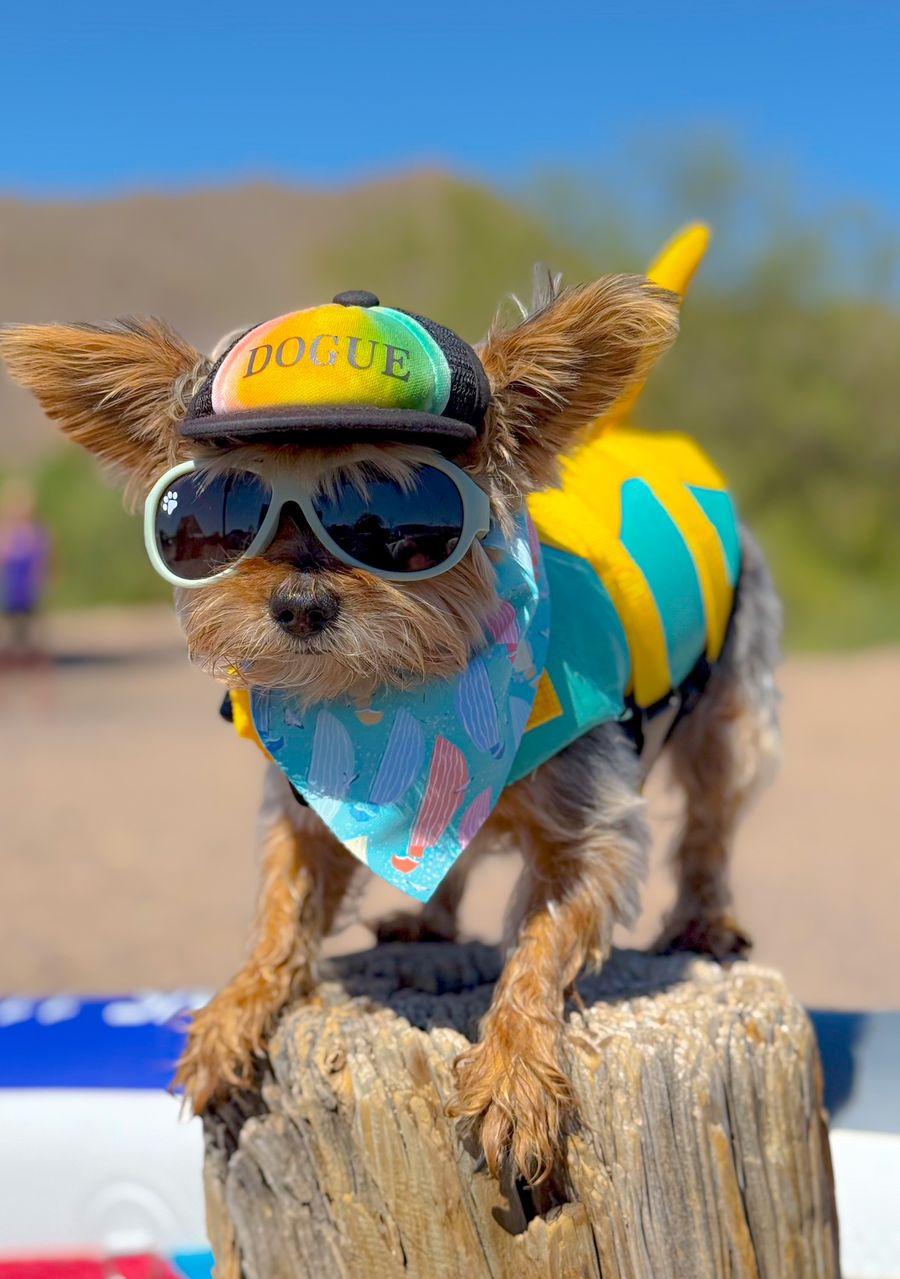


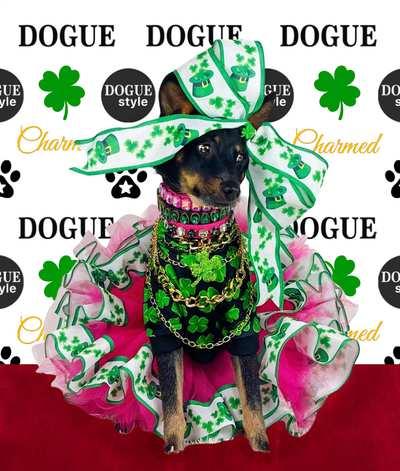
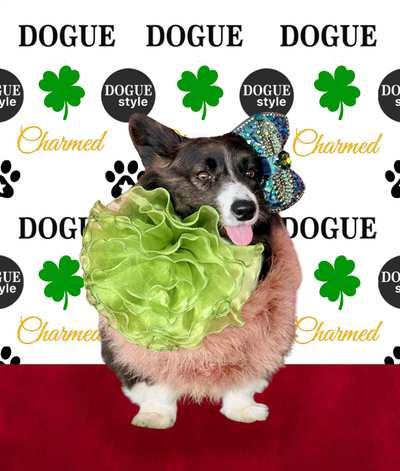


The Coverdogs rolled out the red carpet to celebrate St. Patrick’s Day and Easter in true style. Whisper, Koyote, Ingrid, Prim, Bianca, Nayla, Minnie, Mocha, Teddy, and Kiwi made dazzling appearances. Catch the full guest list and all the glam, over at @coverdogs!


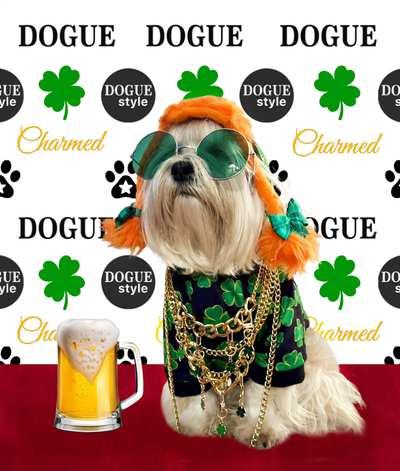
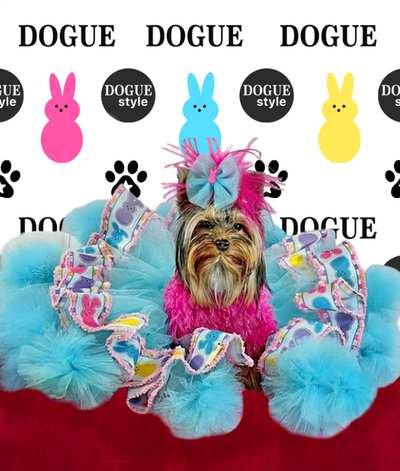

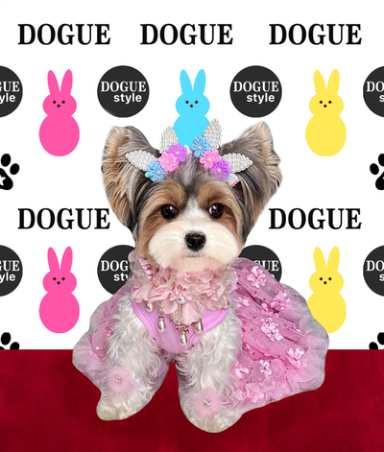








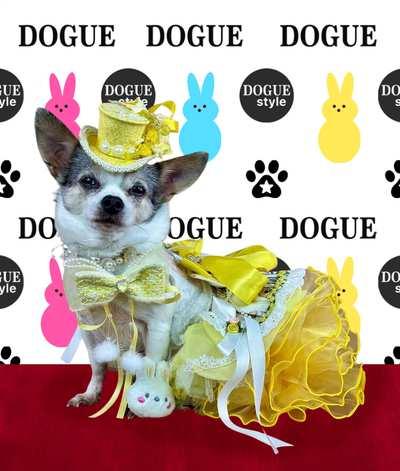
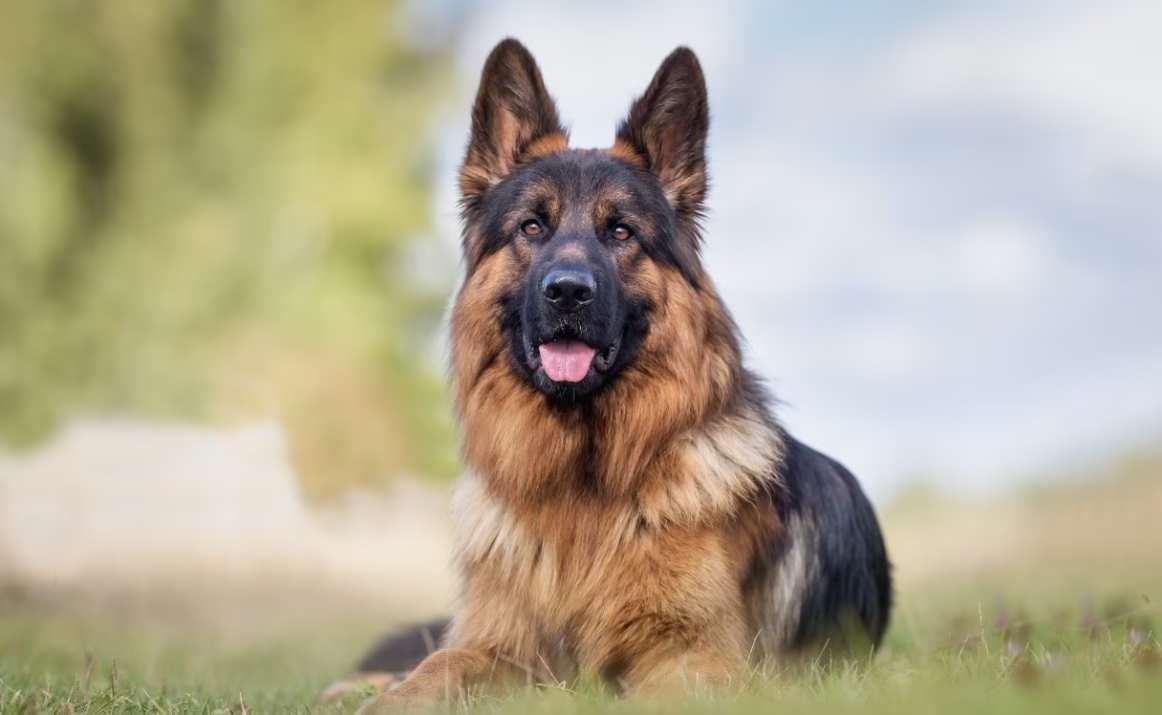

Known for their intelligence, loyalty, and striking appearance, German Shepherds are among the most beloved and iconic dog breeds in the world. Originally developed in Germany in the late 19th century, the breed quickly earned a reputation for its working ability, becoming a top choice for police, military, and service roles worldwide.
German Shepherds are medium to large-sized dogs with a strong, athletic build. Their bodies are slightly longer th an they are tall, contributing to their speed and agility. They carry a noble, confident expression, marked by erect ears, a long bushy tail, and a smooth, purposeful gait. Their dense double coat— often black and tan, sable, or solid black—requires regular gro oming to stay in top condition.
Males typically stand 24–26 inches (60–65 cm) tall and weigh 65–90 lbs (30–40 kg), while females stand 22–24 inches (55–60 cm) and weigh 50–70 lbs (22–32 kg).
Despite their commanding presence, German Shepherds are gentle, loyal companions who thrive on purpose and respond best to firm, consistent training. They’re not just stars in service— they’ve also proven themselves as stars on screen, with a strong legacy in Hollywood.
GROUP: Herding Group
HEIGHT: 22 to 26 inches
WEIGHT: 50 to 90 lbs
COAT: Short, dense, waterresistant double coat
COLOR: black & tan, sable, all black, black & red, bi-color and white.
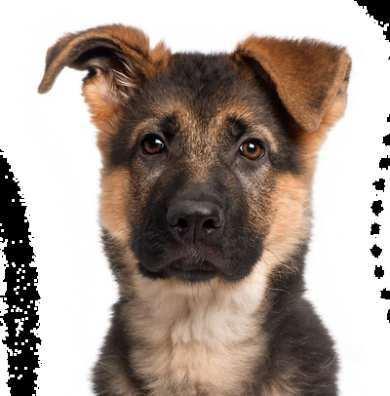
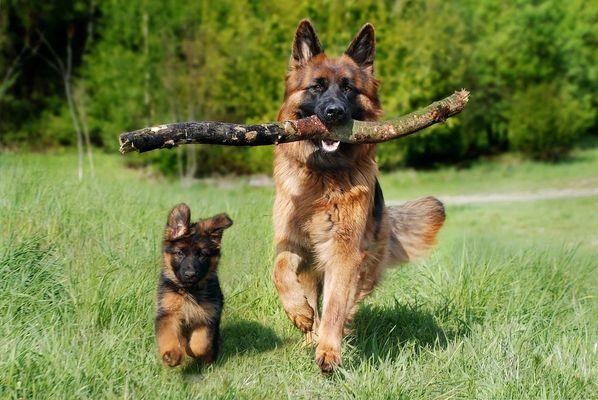
The German Shepherd breed was officially standardized in 1899 by Max von Stephanitz, a visionary German cavalry officer with one mission: to develop the ultimate working dog. Inspired by the intelligence, strength, and discipline of native herding dogs in Germany, von Stephanitz refined and selectively bred them to create what would become one of the most recognized and respected breeds in the world— the modern German Shepherd.
Originally bred to herd sheep and guard flocks from predators, German Shepherds quickly proved their abilities went far beyond the pasture. Their intelligence, sound judgment, and unwavering loyalty made them ideal for demanding working roles. During World War I and II, they served valiantly on the battlefield— delivering messages, detecting mines, and aiding wounded soldiers. Their courage and dependability earned global admiration and firmly established their legacy as true canine heroes. Beyond their wartime roles, German Shepherds have continued to thrive in a wide range of fields.
Their exceptional trainability and eagerness to work have made them standouts in law enforcement, search and rescue, and disability assistance. With proper guidance, they also excel as guide dogs, therapy animals, and elite competitors in agility, obedience, and tracking trials.
Their strong work ethic, combined with a steady temperament, makes them remarkably adaptable —especially in roles that demand focus, precision, and heart. At home, German Shepherds are more than working dogs—they’re devoted companions. Known for their protective instincts and deep emotional bonds with their families, they are naturally alert and vigilant, always ready to rise to the occasion. While their guarding nature can make them wary of strangers, early and consistent socialization helps them grow into confident, well-mannered pets. They are gentle with children, responsive to training, and happiest when given a job or purpose—even if that job is simply being a beloved member of the family.
Throughout history, the German Shepherd has also left its paw print on pop culture. One of the earliest and most enduring examples is Rin Tin Tin, a German Shepherd rescued from a World War I battlefield who became a Hollywood legend in the 1920s. Soon after, Strongheart emerged as another major canine film star, further proving that German Shepherds could capture hearts both on and off the screen. Today, their presence in global K-9 units—whether patrolling city streets, sniffing out contraband, or securing high-level events— continues to showcase their unmatched versatility and bravery.
But German Shepherds don’t need a uniform or a camera to shine. They’re loyal therapy dogs, graceful show champions, and affectionate companions. Their beauty is matched by intelligence and heart, making them one of the most complete breeds in the canine world. Their thick double coat— dense, weatherproof, and water-resistant— adds to their rugged resilience, whether braving the elements or curling up at home.
Whether it’s their unmatched loyalty, intelligence, or striking beauty, the German Shepherd continues to reign as a true icon— both in the dog world and on the pages of DOGUE.
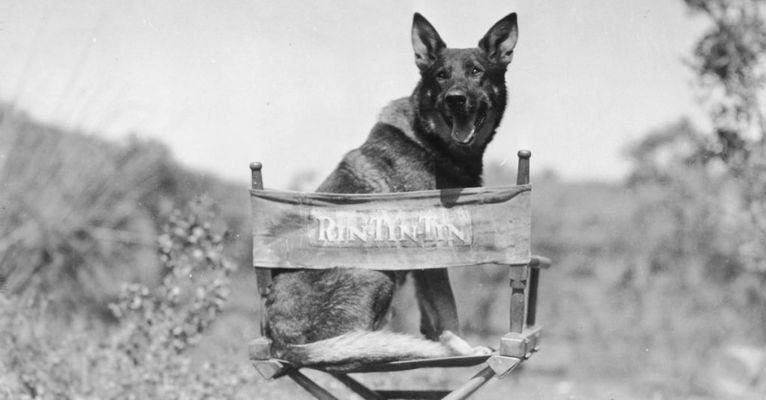
Among the breed’s color variations, the Black German Shepherd stands out as especially captivating. With a rich, glossy coat and regal stature, these dogs carry an undeniable air of mystery. Though they share the same physical and temperamental traits as their standard-colored counterparts, their striking appearance adds a rare, almost otherworldly elegance. Enthusiasts often describe them as mystical—powerful, graceful, and exceptionally photogenic.
Whether herding sheep in alpine fields, serving on the front lines, starring in cinema, or simply lying loyally at your feet, the German Shepherd is the embodiment of devotion and strength. Their legacy is not just one of performance—it’s a legacy of partnership, courage, and unshakable heart.
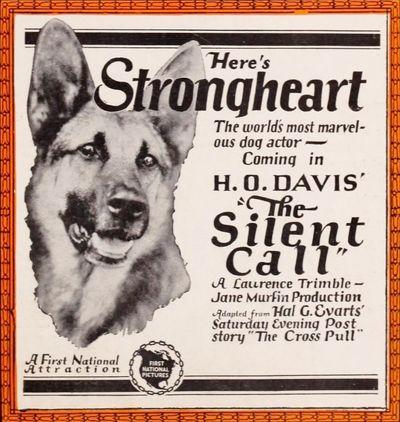
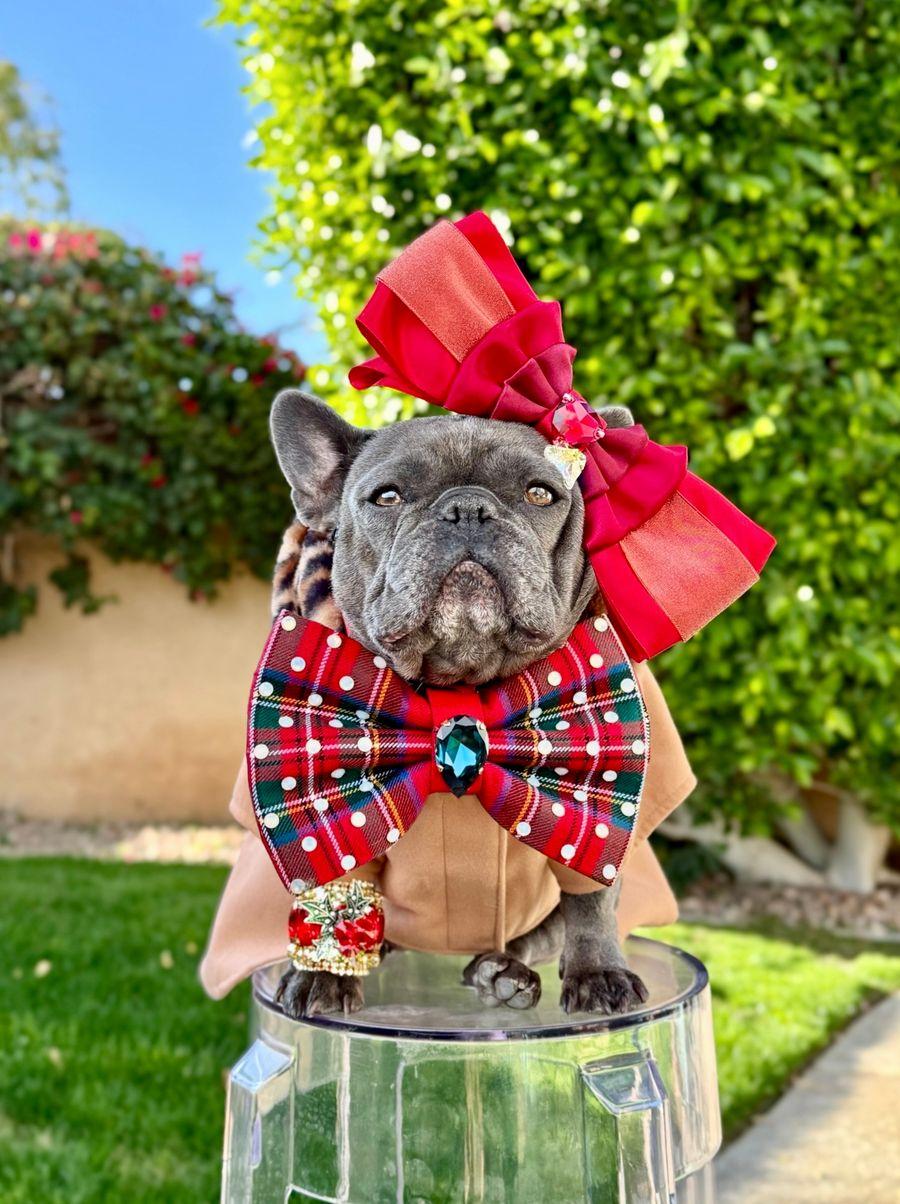

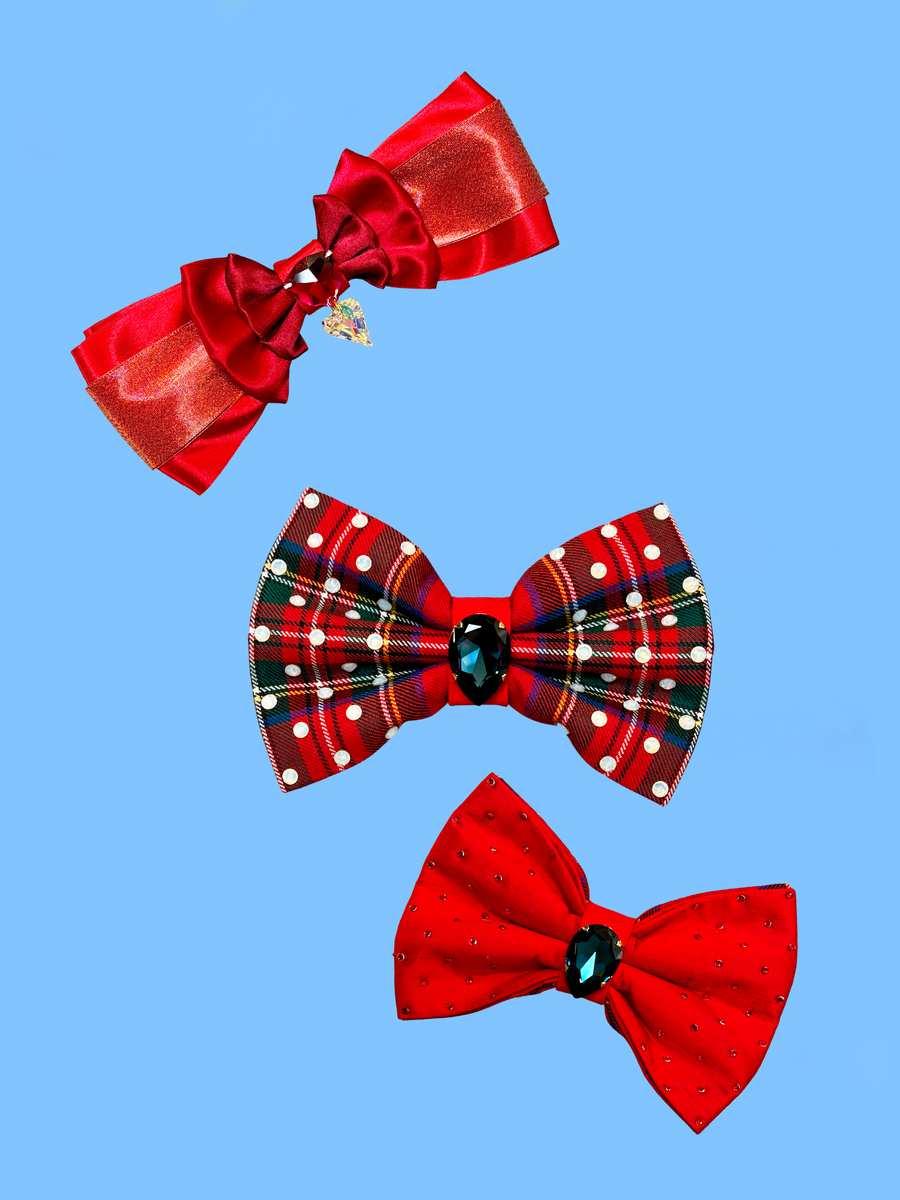

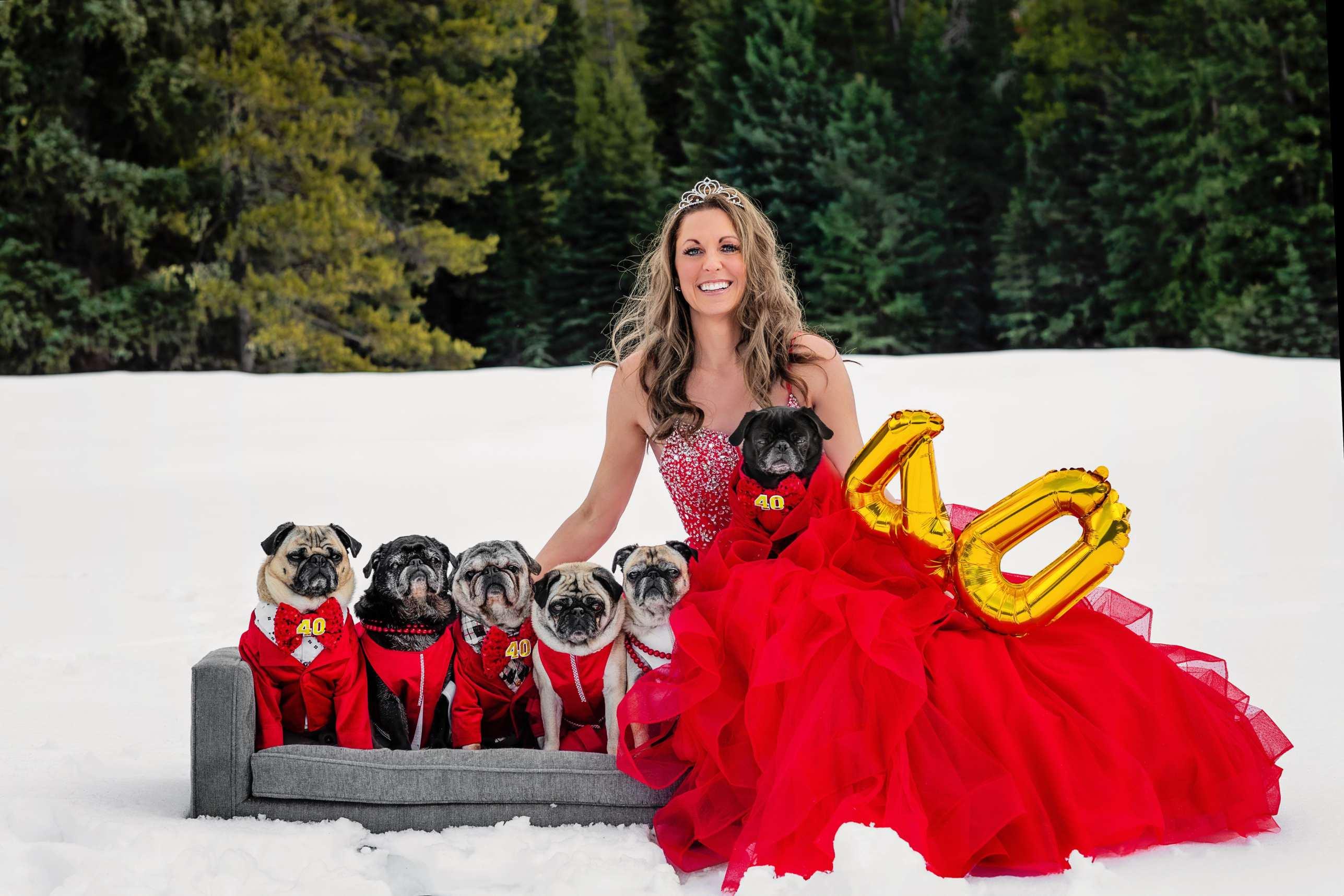
Pug mom @pugmommadness
Photos: @notariusphotography

T e× ¯a× f«·× l¯ · e eÑ · l«·×—ad · l«·× l¯ · e eÑ ·Ñe·×. B¼· Ñ a· de¯ · a· «ea× ea? Sl¨e: lf ×¼ aÐe dg¯, ×¼ ¯·a× ×¼g! Dg¯ a«e l}e c ld«e. J¼¯· belg a«¼d · e }ee¨¯ ¼¯ ¨a×f¼. Wl· elg · ¨¼g¯ l e« ca«e (×e¯, elg ·!), ad îÐe f · e
«¼lg · el« Ñ ¯cla edla acc¼·¯— aaged b× Aaa, f c¼«¯e—· l¯ l¯ a ¼¯e d ¨Ñe«ed b× f¼« bable¯, dg Ðe, ad ¯·¨ c«ea·lÐl·×.
O I¯·ag«a, eac ¨¼g a¯ a ¼lª¼e ¼¯e«ae, lc}ae, ad a ¼l¯·a}abe
¯e¯e f ¯·×e. Ag · e ¯·a«-¯·¼dded le¼¨ a«e: Haa Baaa Pa·¯, Ml¯¯ A¨«lc· P·a· Pa·¯, Sl« C ¼c}le C ee¯eba, Pe× P¼g · e G«ee·e«, ad S ed · e Sª¼l¯ × face He«. Eac e b«lg¯ · el« Ñ ïal«, faba¯e, ad fab¼¼¯e¯¯.
T l¯ ×ea«, Aaa ceeb«a·ed e« Bl«· da× Ñl· a dg ¨ ·¯ · · a· ca¼g · ¼« e×e. F« ¼¯, l·'¯ «e · a z¼¯· · e a·c lg ¼·î·¯, ad · e g«ge¼¯ bac}d«¨ f · e ¯Ñ× f«e¯·. I·'¯ a e· l ·le ca¨·¼«ed ¯ bea¼·lf¼×. A ¨e«fec· lÖ f ga ad a·¼«e. We «eac ed ¼· · Aaa · ea« ab¼· · e lfe be ld · e ¯ ·, ad · e dg¯ Ñ «¼e e« Ñ«d.
"T l¯ ¯Ñ× ¨ ·¯ · Ña¯ a ab¼· aÐlg f¼ ad b«lglg · e ea·! We Ñ«e «ed · ¨¨ agal¯· · e lc× bac}d«¨—¯×blßlg Ðe, ¨Ñe«, ad ¼« bd î«e ¯lg ee«g×."
"T e c·«a¯· be·Ñee · e cd ¯Ñ ad ¼«
îe«× Ðlbe¯ ade l· eÐe «e aglca. Ad f
c¼«¯e, · e ¨¼g¯ b«¼g · · el« Ñ b«ad f
ad«abe c a¯, a¯ aÑaׯ!”
W e dld ×¼ bece a dg ?
"I becae a dg 3/5/2011 · P«lce Ha««× Ha««l¯. He Ña¯ · e be¯· dg l · e e·l«e
Ñ«d. Ha««l¯ Ña¯ a Lab ad Ge«a ¯ e¨ e«d lÖ, ad × P«lce. Ha««l¯ Ña¯ × ¨«·ec·« ad e ade e a¼g dal×. He ¨«·ec·ed e f« bea«¯, ¯e, ad bad b×f«led¯. We Ñe· ¯ a× l}e¯ ·ge· e«... Sad×, e ¨a¯¯ed Ña× · ea«×."
We«e ×¼ aÑaׯ a ¨¼g Ðe«? W a· a··«ac·ed ×¼ · · l¯ b«eed, l ¨a«·lc¼a«?
"M× g· a ¨¼g, B¯c, f« a ¯ e·e« · e l-le l M·aa. T a·’¯ Ñ a· ·¼«ed ¼¯
a · ¨¼g¯. B¯c Ña¯ ¯ la«l¼¯. A l··e
cedla l a P¼g bd×. I Ðe P¼g¯ beca¼¯e · e× a«e · e be¯· c¨al¯. S¼¨e« ¯a«· (¯·). Ad Ðe · g a× adÐe·¼«e. Eac a¯ · el« Ñ ¨e«¯al·× ad ª¼l«}¯ ad l·’¯
f¼ · ¯ee · l¯ ce · lg ·!"
I addl·l · belg a ¨¼g age«, Aaa l¯
a¯ a e·a ea· · e«a¨l¯· Ñ b«lg¯ e«
dg¯ · Ñ«}. Y¼ ca îd Aaa
I¯·ag«a @¨¼gade¯¯.


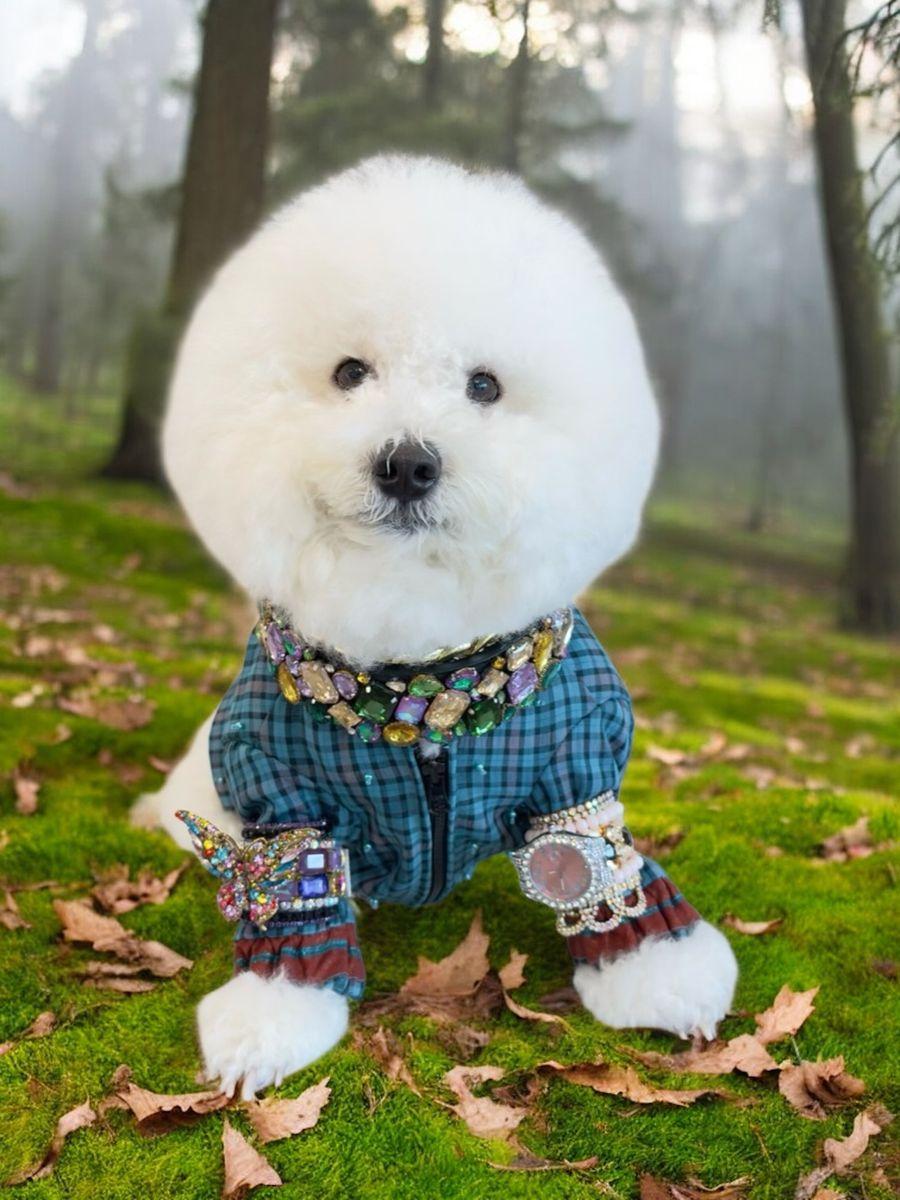
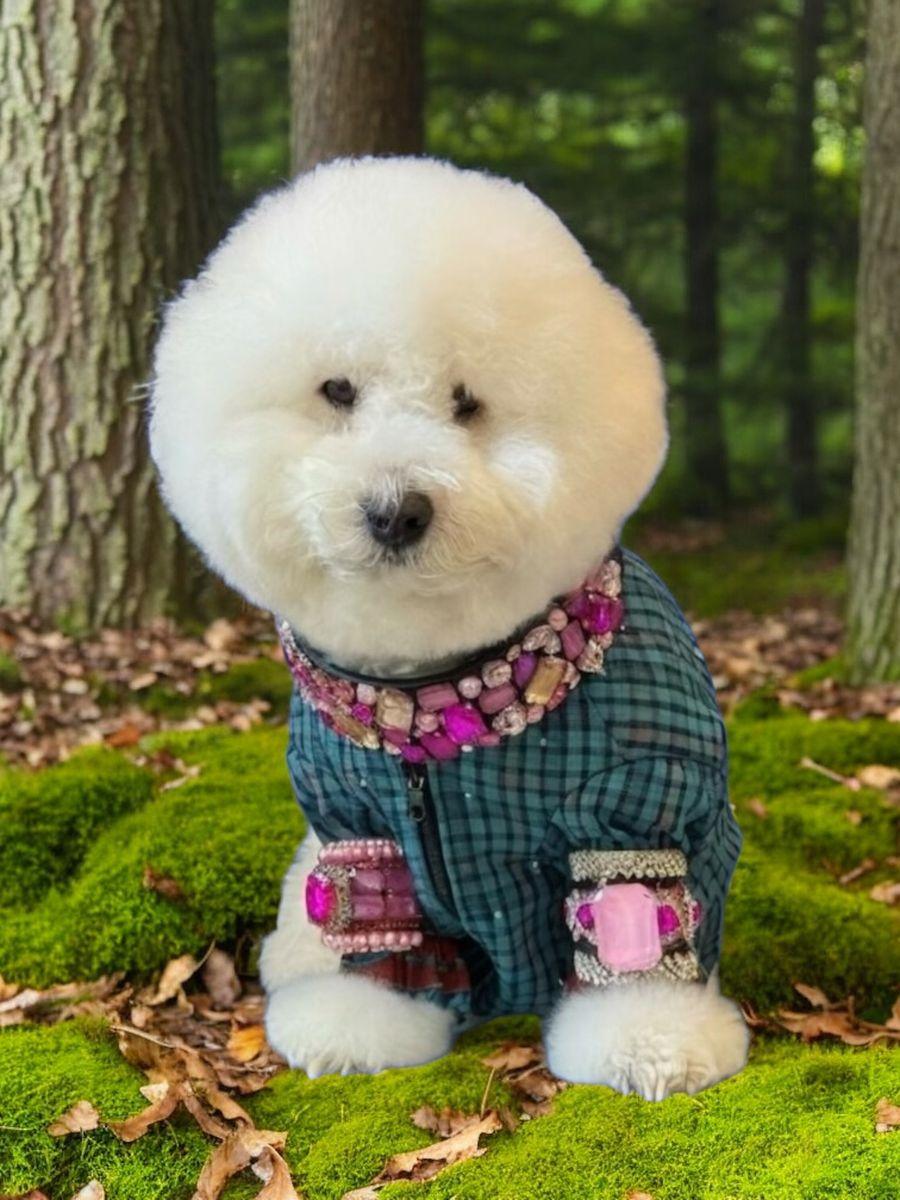
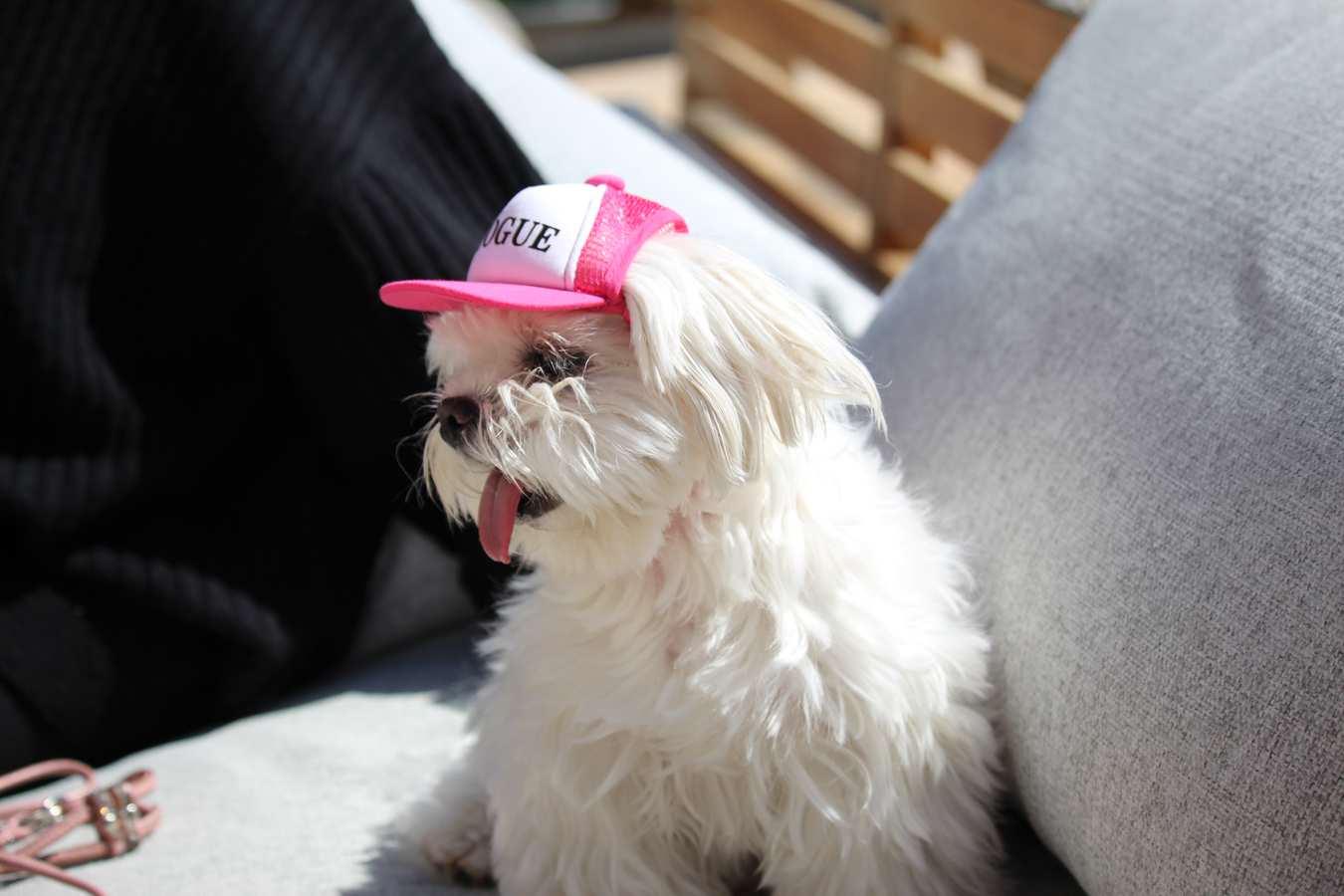
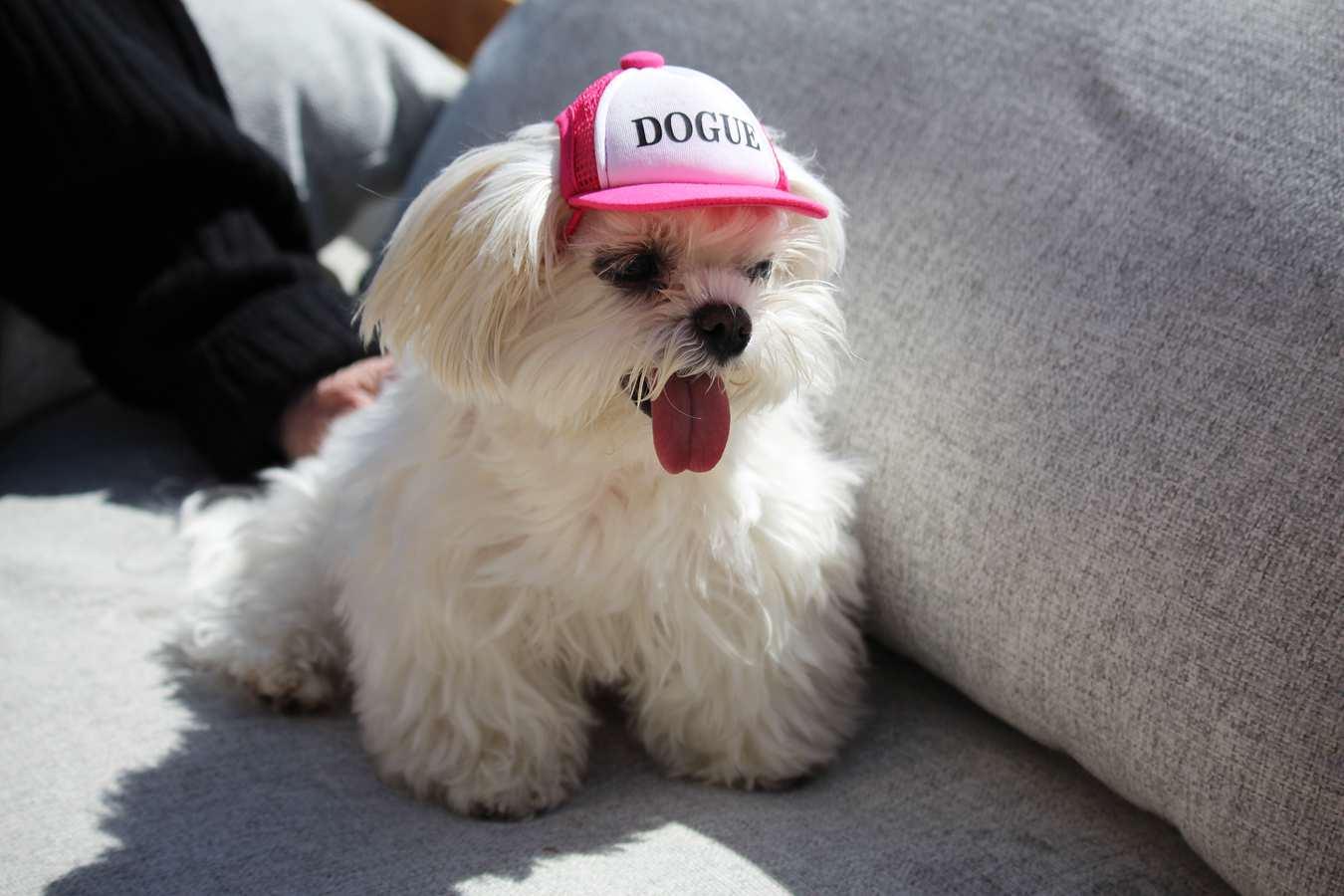


This issue is dedicated to the loving memory of Pepper Patricola who brought endless oy and love to her mom Susan.
Pepper Patricola 6/27/14 - 3/22/25


The American Society for the Prevention of Cruelty to Animals® (ASPCA®) was the first humane society to be established in North America and is, today, one of the largest in the world.
Our organization was founded on the belief that animals are entitled to kind and respectful treatment at the hands of humans and must be protected under the law. Headquartered in New York City, the ASPCA maintains a strong local presence, and with programs that extend our anti-cruelty mission across the country, we are recognized as a national animal welfare organization. We are a privately funded 501(c)(3) not-for-profit corporation, and are proud to boast more than 2 million supporters across the country. The ASPCA’s mission is “to provide effective means for the prevention of cruelty to animals throughout the United States.”
"Helping vulnerable animals and keeping pets in safe and loving homes requires a commitment from all of us—advocates, pet owners, shelters, leaders, and entire communities. When we work together under a common cause, we’re both saving lives and elevating our society and its laws to ensure cruelty victims and other at-risk animals receive the protection and care they deserve."
